Tesla: Revolutionizing Sustainable Transportation and Renewable Energy Solutions
VerifiedAdded on 2023/06/20
|34
|9670
|89
AI Summary
This report focuses on Tesla, a prominent player in the automotive industry known for its electric vehicles (EVs) and commitment to sustainable energy. Tesla's mission extends beyond EV production, encompassing renewable energy solutions like solar power and energy storage. The company's strategy involves offering affordable EVs, expanding manufacturing capabilities, and utilizing a unique distribution model. Challenges include scaling up production to meet demand and ensuring financial viability due to high manufacturing costs. The report also highlights the leadership of Elon Musk, Tesla's CEO, and the changing customer behavior toward sustainable mobility solutions. Additionally, it discusses the growing EV market and its potential in various countries, particularly China.
Contribute Materials
Your contribution can guide someone’s learning journey. Share your
documents today.
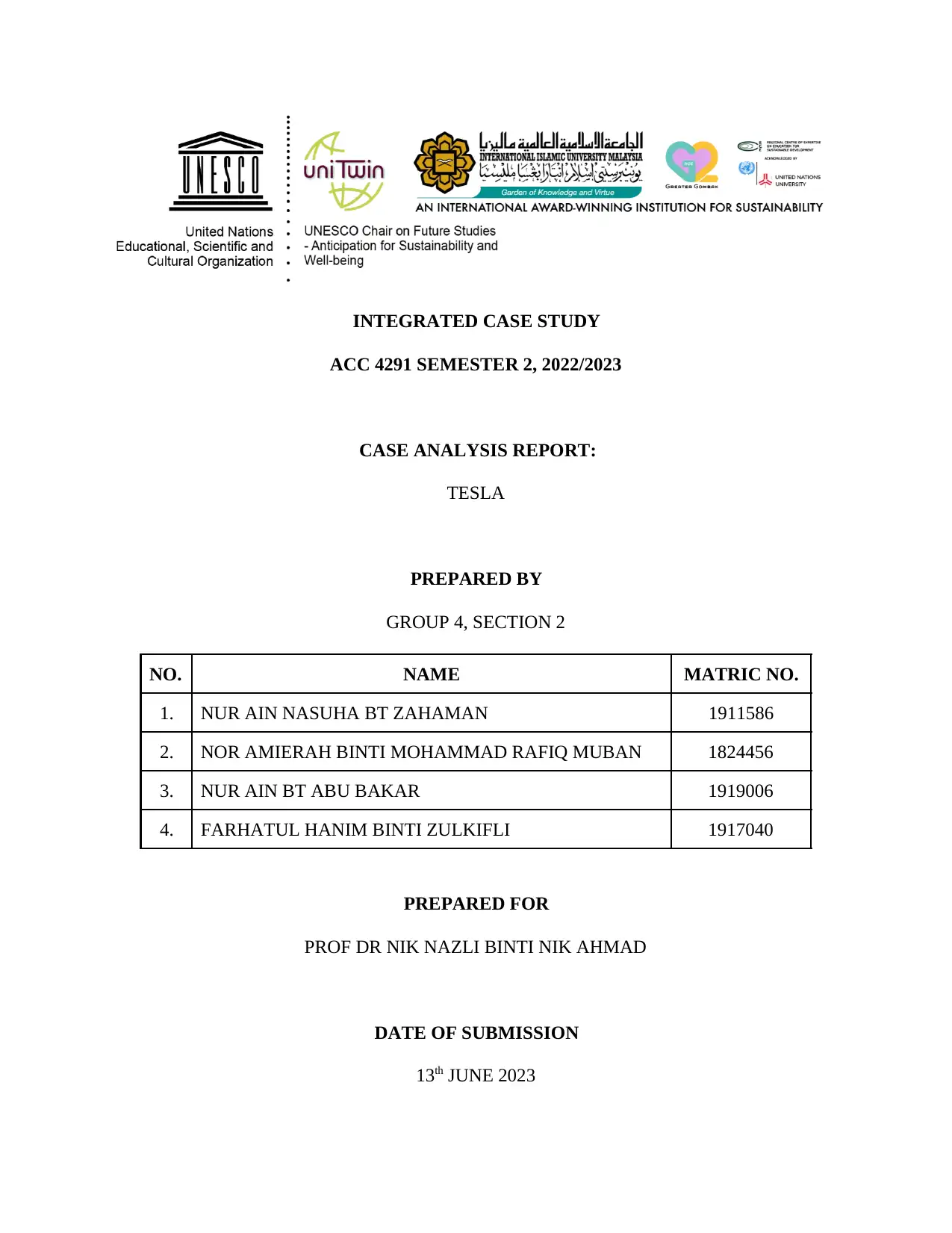
INTEGRATED CASE STUDY
ACC 4291 SEMESTER 2, 2022/2023
CASE ANALYSIS REPORT:
TESLA
PREPARED BY
GROUP 4, SECTION 2
NO. NAME MATRIC NO.
1. NUR AIN NASUHA BT ZAHAMAN 1911586
2. NOR AMIERAH BINTI MOHAMMAD RAFIQ MUBAN 1824456
3. NUR AIN BT ABU BAKAR 1919006
4. FARHATUL HANIM BINTI ZULKIFLI 1917040
PREPARED FOR
PROF DR NIK NAZLI BINTI NIK AHMAD
DATE OF SUBMISSION
13th JUNE 2023
ACC 4291 SEMESTER 2, 2022/2023
CASE ANALYSIS REPORT:
TESLA
PREPARED BY
GROUP 4, SECTION 2
NO. NAME MATRIC NO.
1. NUR AIN NASUHA BT ZAHAMAN 1911586
2. NOR AMIERAH BINTI MOHAMMAD RAFIQ MUBAN 1824456
3. NUR AIN BT ABU BAKAR 1919006
4. FARHATUL HANIM BINTI ZULKIFLI 1917040
PREPARED FOR
PROF DR NIK NAZLI BINTI NIK AHMAD
DATE OF SUBMISSION
13th JUNE 2023
Secure Best Marks with AI Grader
Need help grading? Try our AI Grader for instant feedback on your assignments.
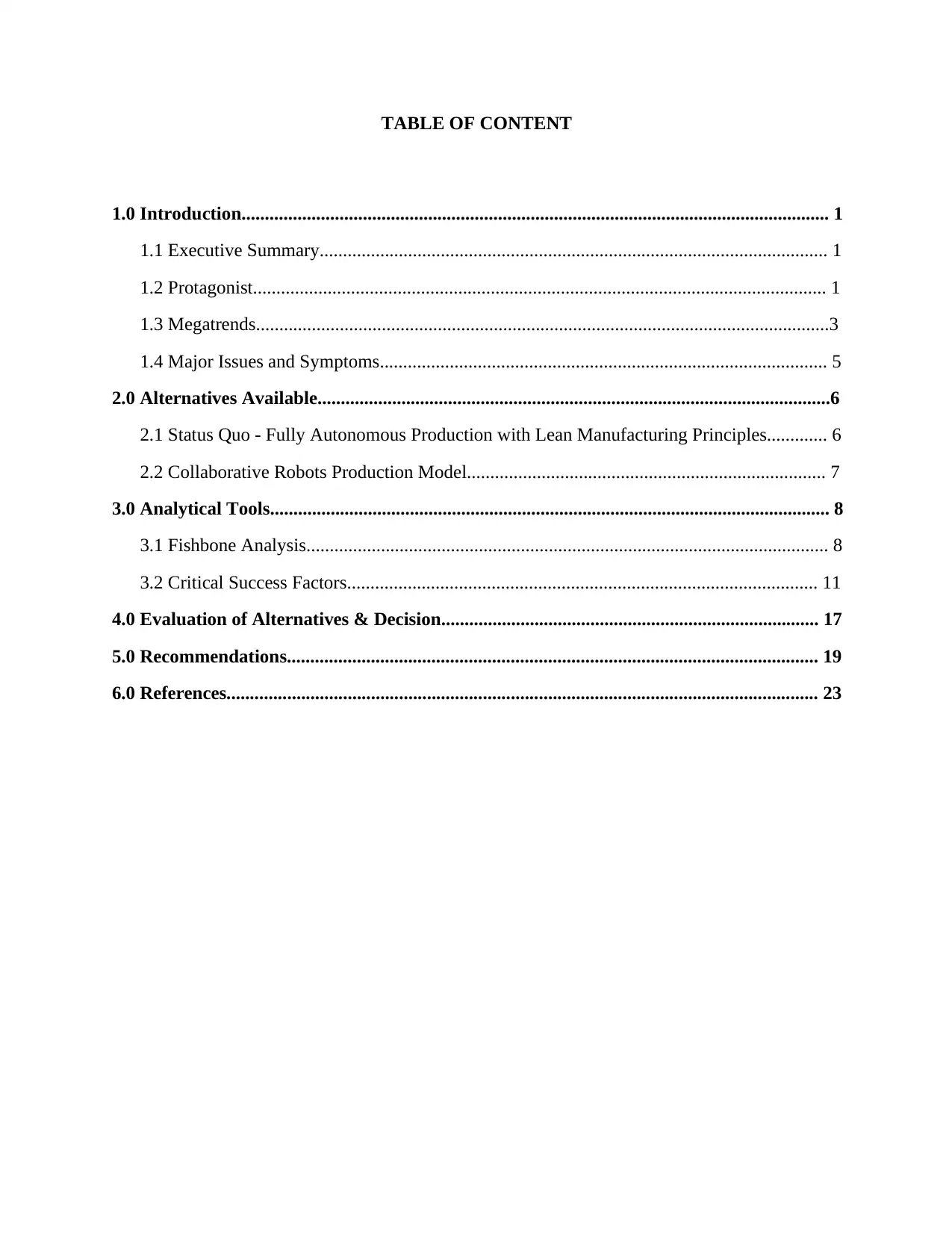
TABLE OF CONTENT
1.0 Introduction.............................................................................................................................. 1
1.1 Executive Summary............................................................................................................. 1
1.2 Protagonist........................................................................................................................... 1
1.3 Megatrends...........................................................................................................................3
1.4 Major Issues and Symptoms................................................................................................ 5
2.0 Alternatives Available..............................................................................................................6
2.1 Status Quo - Fully Autonomous Production with Lean Manufacturing Principles............. 6
2.2 Collaborative Robots Production Model............................................................................. 7
3.0 Analytical Tools........................................................................................................................ 8
3.1 Fishbone Analysis................................................................................................................ 8
3.2 Critical Success Factors..................................................................................................... 11
4.0 Evaluation of Alternatives & Decision................................................................................. 17
5.0 Recommendations.................................................................................................................. 19
6.0 References............................................................................................................................... 23
1.0 Introduction.............................................................................................................................. 1
1.1 Executive Summary............................................................................................................. 1
1.2 Protagonist........................................................................................................................... 1
1.3 Megatrends...........................................................................................................................3
1.4 Major Issues and Symptoms................................................................................................ 5
2.0 Alternatives Available..............................................................................................................6
2.1 Status Quo - Fully Autonomous Production with Lean Manufacturing Principles............. 6
2.2 Collaborative Robots Production Model............................................................................. 7
3.0 Analytical Tools........................................................................................................................ 8
3.1 Fishbone Analysis................................................................................................................ 8
3.2 Critical Success Factors..................................................................................................... 11
4.0 Evaluation of Alternatives & Decision................................................................................. 17
5.0 Recommendations.................................................................................................................. 19
6.0 References............................................................................................................................... 23
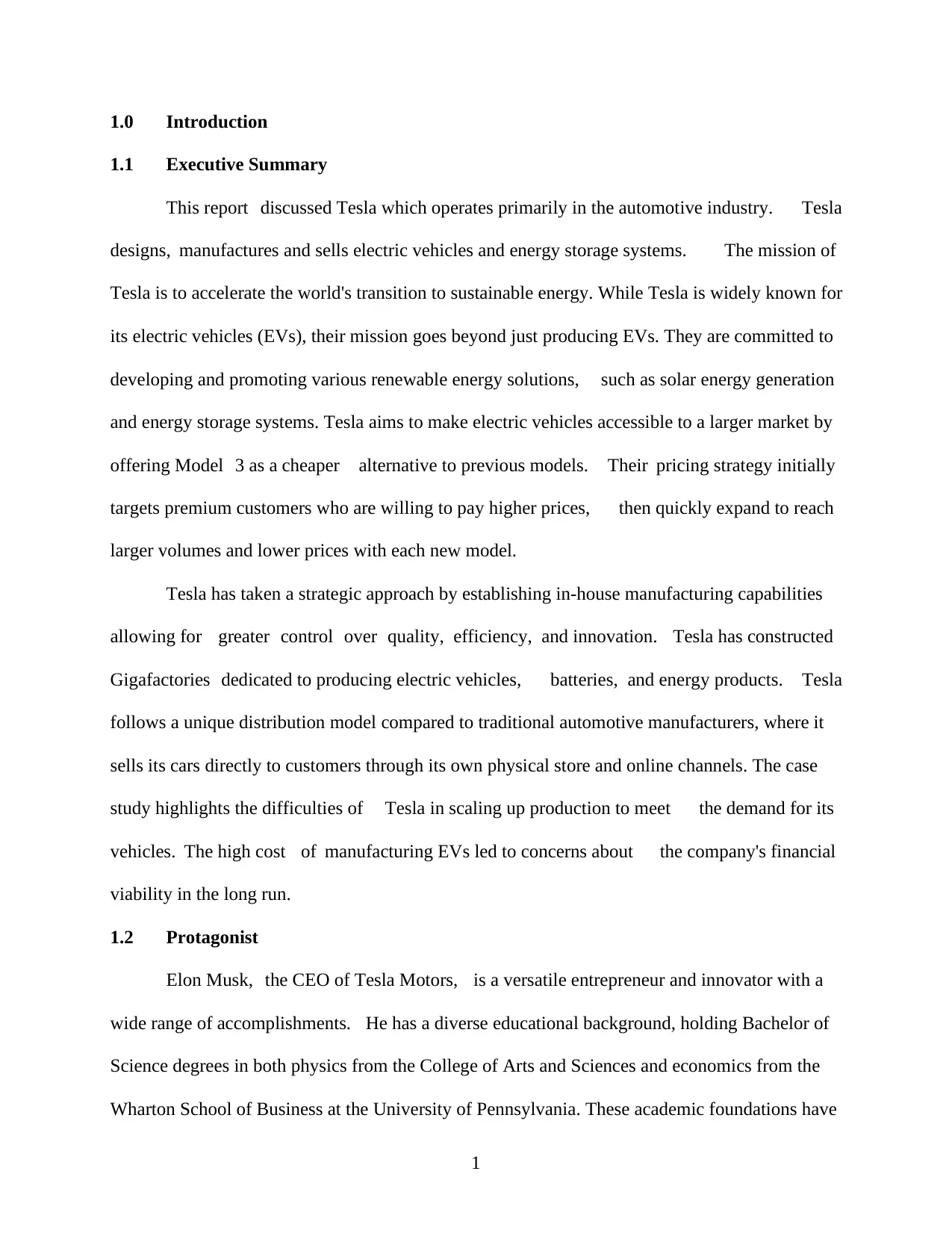
1.0 Introduction
1.1 Executive Summary
This report discussed Tesla which operates primarily in the automotive industry. Tesla
designs, manufactures and sells electric vehicles and energy storage systems. The mission of
Tesla is to accelerate the world's transition to sustainable energy. While Tesla is widely known for
its electric vehicles (EVs), their mission goes beyond just producing EVs. They are committed to
developing and promoting various renewable energy solutions, such as solar energy generation
and energy storage systems. Tesla aims to make electric vehicles accessible to a larger market by
offering Model 3 as a cheaper alternative to previous models. Their pricing strategy initially
targets premium customers who are willing to pay higher prices, then quickly expand to reach
larger volumes and lower prices with each new model.
Tesla has taken a strategic approach by establishing in-house manufacturing capabilities
allowing for greater control over quality, efficiency, and innovation. Tesla has constructed
Gigafactories dedicated to producing electric vehicles, batteries, and energy products. Tesla
follows a unique distribution model compared to traditional automotive manufacturers, where it
sells its cars directly to customers through its own physical store and online channels. The case
study highlights the difficulties of Tesla in scaling up production to meet the demand for its
vehicles. The high cost of manufacturing EVs led to concerns about the company's financial
viability in the long run.
1.2 Protagonist
Elon Musk, the CEO of Tesla Motors, is a versatile entrepreneur and innovator with a
wide range of accomplishments. He has a diverse educational background, holding Bachelor of
Science degrees in both physics from the College of Arts and Sciences and economics from the
Wharton School of Business at the University of Pennsylvania. These academic foundations have
1
1.1 Executive Summary
This report discussed Tesla which operates primarily in the automotive industry. Tesla
designs, manufactures and sells electric vehicles and energy storage systems. The mission of
Tesla is to accelerate the world's transition to sustainable energy. While Tesla is widely known for
its electric vehicles (EVs), their mission goes beyond just producing EVs. They are committed to
developing and promoting various renewable energy solutions, such as solar energy generation
and energy storage systems. Tesla aims to make electric vehicles accessible to a larger market by
offering Model 3 as a cheaper alternative to previous models. Their pricing strategy initially
targets premium customers who are willing to pay higher prices, then quickly expand to reach
larger volumes and lower prices with each new model.
Tesla has taken a strategic approach by establishing in-house manufacturing capabilities
allowing for greater control over quality, efficiency, and innovation. Tesla has constructed
Gigafactories dedicated to producing electric vehicles, batteries, and energy products. Tesla
follows a unique distribution model compared to traditional automotive manufacturers, where it
sells its cars directly to customers through its own physical store and online channels. The case
study highlights the difficulties of Tesla in scaling up production to meet the demand for its
vehicles. The high cost of manufacturing EVs led to concerns about the company's financial
viability in the long run.
1.2 Protagonist
Elon Musk, the CEO of Tesla Motors, is a versatile entrepreneur and innovator with a
wide range of accomplishments. He has a diverse educational background, holding Bachelor of
Science degrees in both physics from the College of Arts and Sciences and economics from the
Wharton School of Business at the University of Pennsylvania. These academic foundations have
1

provided a strong basis for his various ventures. As of May 31, 2023, Musk's net worth stands at
$195.6 billion, making him the second wealthiest individual globally. Alongside his role at Tesla,
he also serves as the founder, CEO, and chief engineer of SpaceX, demonstrating his ambitious
pursuit of revolutionizing space exploration. Moreover, Musk is an angel investor and holds key
positions, including CEO and product architect at Tesla, Inc., owner and CEO of Twitter, Inc.,
founder of the Boring Company, co-founder of Neuralink and OpenAI, and president of the Musk
Foundation, a philanthropic organization. His substantial ownership stake of approximately 23%
in Tesla, encompassing both stock and options, further underscores his dedication to the
company's success and his vision for a sustainable future. Musk has established Tesla as a leader
in the electric vehicle market with his passion and audacious vision, upending established
conventions and changing how we think about transportation. Tesla has become a representation
of cutting-edge technology as a result of his persistent dedication to innovation and sustainability.
Musk's visionary leadership motivates a global shift towards renewable energy, driving society
towards a more sustainable and greener future. It seems that Elon Musk's primary concern was
ensuring Tesla's ability to meet the increasing demand for its electric vehicles and reduce its
reliance on external suppliers. Musk recognized the importance of achieving self-sufficiency in
terms of vehicle components and parts to expand Tesla's manufacturing capabilities and stay
competitive in the market. Although Tesla faced production delays due to capacity constraints, it
managed to boost production significantly by implementing higher levels of automation and
increasing its workforce. However, there were also challenges related to delivery logistics,
including transportation and quality control issues, that needed to be addressed. Initially, Tesla's
strategy of offering differentiated products proved successful in attracting a niche market
segment, but there was a growing demand for Tesla's more affordable vehicles in the mass
market.
2
$195.6 billion, making him the second wealthiest individual globally. Alongside his role at Tesla,
he also serves as the founder, CEO, and chief engineer of SpaceX, demonstrating his ambitious
pursuit of revolutionizing space exploration. Moreover, Musk is an angel investor and holds key
positions, including CEO and product architect at Tesla, Inc., owner and CEO of Twitter, Inc.,
founder of the Boring Company, co-founder of Neuralink and OpenAI, and president of the Musk
Foundation, a philanthropic organization. His substantial ownership stake of approximately 23%
in Tesla, encompassing both stock and options, further underscores his dedication to the
company's success and his vision for a sustainable future. Musk has established Tesla as a leader
in the electric vehicle market with his passion and audacious vision, upending established
conventions and changing how we think about transportation. Tesla has become a representation
of cutting-edge technology as a result of his persistent dedication to innovation and sustainability.
Musk's visionary leadership motivates a global shift towards renewable energy, driving society
towards a more sustainable and greener future. It seems that Elon Musk's primary concern was
ensuring Tesla's ability to meet the increasing demand for its electric vehicles and reduce its
reliance on external suppliers. Musk recognized the importance of achieving self-sufficiency in
terms of vehicle components and parts to expand Tesla's manufacturing capabilities and stay
competitive in the market. Although Tesla faced production delays due to capacity constraints, it
managed to boost production significantly by implementing higher levels of automation and
increasing its workforce. However, there were also challenges related to delivery logistics,
including transportation and quality control issues, that needed to be addressed. Initially, Tesla's
strategy of offering differentiated products proved successful in attracting a niche market
segment, but there was a growing demand for Tesla's more affordable vehicles in the mass
market.
2
Secure Best Marks with AI Grader
Need help grading? Try our AI Grader for instant feedback on your assignments.
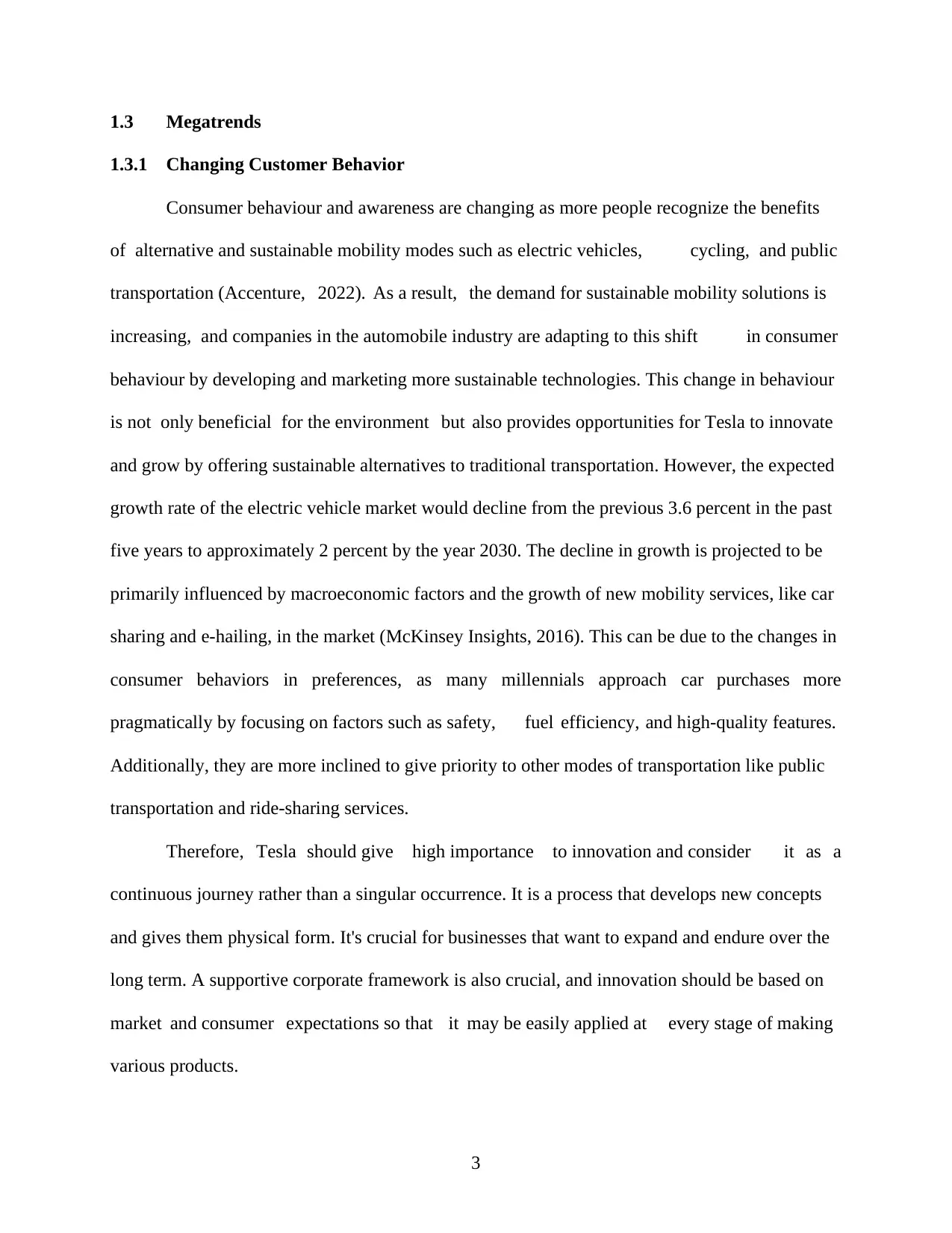
1.3 Megatrends
1.3.1 Changing Customer Behavior
Consumer behaviour and awareness are changing as more people recognize the benefits
of alternative and sustainable mobility modes such as electric vehicles, cycling, and public
transportation (Accenture, 2022). As a result, the demand for sustainable mobility solutions is
increasing, and companies in the automobile industry are adapting to this shift in consumer
behaviour by developing and marketing more sustainable technologies. This change in behaviour
is not only beneficial for the environment but also provides opportunities for Tesla to innovate
and grow by offering sustainable alternatives to traditional transportation. However, the expected
growth rate of the electric vehicle market would decline from the previous 3.6 percent in the past
five years to approximately 2 percent by the year 2030. The decline in growth is projected to be
primarily influenced by macroeconomic factors and the growth of new mobility services, like car
sharing and e-hailing, in the market (McKinsey Insights, 2016). This can be due to the changes in
consumer behaviors in preferences, as many millennials approach car purchases more
pragmatically by focusing on factors such as safety, fuel efficiency, and high-quality features.
Additionally, they are more inclined to give priority to other modes of transportation like public
transportation and ride-sharing services.
Therefore, Tesla should give high importance to innovation and consider it as a
continuous journey rather than a singular occurrence. It is a process that develops new concepts
and gives them physical form. It's crucial for businesses that want to expand and endure over the
long term. A supportive corporate framework is also crucial, and innovation should be based on
market and consumer expectations so that it may be easily applied at every stage of making
various products.
3
1.3.1 Changing Customer Behavior
Consumer behaviour and awareness are changing as more people recognize the benefits
of alternative and sustainable mobility modes such as electric vehicles, cycling, and public
transportation (Accenture, 2022). As a result, the demand for sustainable mobility solutions is
increasing, and companies in the automobile industry are adapting to this shift in consumer
behaviour by developing and marketing more sustainable technologies. This change in behaviour
is not only beneficial for the environment but also provides opportunities for Tesla to innovate
and grow by offering sustainable alternatives to traditional transportation. However, the expected
growth rate of the electric vehicle market would decline from the previous 3.6 percent in the past
five years to approximately 2 percent by the year 2030. The decline in growth is projected to be
primarily influenced by macroeconomic factors and the growth of new mobility services, like car
sharing and e-hailing, in the market (McKinsey Insights, 2016). This can be due to the changes in
consumer behaviors in preferences, as many millennials approach car purchases more
pragmatically by focusing on factors such as safety, fuel efficiency, and high-quality features.
Additionally, they are more inclined to give priority to other modes of transportation like public
transportation and ride-sharing services.
Therefore, Tesla should give high importance to innovation and consider it as a
continuous journey rather than a singular occurrence. It is a process that develops new concepts
and gives them physical form. It's crucial for businesses that want to expand and endure over the
long term. A supportive corporate framework is also crucial, and innovation should be based on
market and consumer expectations so that it may be easily applied at every stage of making
various products.
3

1.3.2 Growing Electrical Vehicle Market
Many developed countries have responded to the environmental crisis, energy security
issues, and an increase in the demand for automobiles, especially in the electronic vehicle
industry. According to Figure 1, as per Appendix 2, the market share of electric vehicles
worldwide experienced a remarkable increase trend between 2010 and 2016, and the sector is
currently in a growth stage (Zhao et. al., 2020). This could be seen through the rapid growth of
the electric vehicle (EV) industry, especially in China. One crucial aspect is the growing
purchasing power of the country's population, which has made electric vehicles more affordable
for a larger number of consumers. Additionally, the government has introduced incentives such as
subsidies and tax advantages to encourage the adoption of EVs and tackle environmental issues.
The combination of increasing consumer interest, government backing, and environmental
pressures has led to significant advancements in China's electric vehicle sector, garnering
attention from researchers and industry experts. However, having a sufficient and accessible
charging infrastructure is vital to encourage the widespread use of electric vehicles. If there are
not enough charging stations or limited access to them, it can cause inconvenience and anxiety
for EV owners, which ultimately hampers the overall rate of EV adoption because potential
purchasers have range anxiety due to a shortage of charging stations. Expanding the charging
infrastructure is of utmost importance to sustain the increasing electric vehicle market (Livemint,
2022). Tesla has gradually shifted from producing exclusive products to mass manufacturing in
response to the increasing demand for electric vehicles. Tesla is also upgrading its services by
adding charging stations with 120 kW capacity, an improvement above the industry's standard 50
kW fast charging stations. Additionally, Tesla develops a competitive edge in leveraging
renewable energy by setting up free solar-powered charging stations close to its sales areas. Solar
panels initially have carbon dioxide emissions during their manufacturing process. Still, they
4
Many developed countries have responded to the environmental crisis, energy security
issues, and an increase in the demand for automobiles, especially in the electronic vehicle
industry. According to Figure 1, as per Appendix 2, the market share of electric vehicles
worldwide experienced a remarkable increase trend between 2010 and 2016, and the sector is
currently in a growth stage (Zhao et. al., 2020). This could be seen through the rapid growth of
the electric vehicle (EV) industry, especially in China. One crucial aspect is the growing
purchasing power of the country's population, which has made electric vehicles more affordable
for a larger number of consumers. Additionally, the government has introduced incentives such as
subsidies and tax advantages to encourage the adoption of EVs and tackle environmental issues.
The combination of increasing consumer interest, government backing, and environmental
pressures has led to significant advancements in China's electric vehicle sector, garnering
attention from researchers and industry experts. However, having a sufficient and accessible
charging infrastructure is vital to encourage the widespread use of electric vehicles. If there are
not enough charging stations or limited access to them, it can cause inconvenience and anxiety
for EV owners, which ultimately hampers the overall rate of EV adoption because potential
purchasers have range anxiety due to a shortage of charging stations. Expanding the charging
infrastructure is of utmost importance to sustain the increasing electric vehicle market (Livemint,
2022). Tesla has gradually shifted from producing exclusive products to mass manufacturing in
response to the increasing demand for electric vehicles. Tesla is also upgrading its services by
adding charging stations with 120 kW capacity, an improvement above the industry's standard 50
kW fast charging stations. Additionally, Tesla develops a competitive edge in leveraging
renewable energy by setting up free solar-powered charging stations close to its sales areas. Solar
panels initially have carbon dioxide emissions during their manufacturing process. Still, they
4

achieve carbon neutrality within two years and can last for more than 20 years, making them vital
in reducing carbon emissions and will help the nation reach the proposed US federal plan of a
30% reduction in 2005 carbon emission levels from the electric power sector by 2030 (Robinson
et al., 2014, p. 7360). Tesla can take advantage of the rising demand for electric vehicles by
developing its network of charging infrastructure and collaborating with local organizations to
increase accessibility and convenience for EV owners.
1.4 Major Issues and Symptoms
This case study revealed three primary symptoms influenced by both external and internal
factors: Tesla's production, financial stability, and competition. Regarding Tesla's production, the
company encountered significant challenges and difficulties in scaling up production, leading to
what was commonly referred to as "production hell." Tesla faced various obstacles, including
paused production, as they worked on addressing bottlenecks in their highly automated factory.
CEO Elon Musk acknowledged that excessive automation was part of the problem, resulting in
issues along the production line. In an attempt to meet production targets, Tesla even skipped
some production processes to save time. However, despite these efforts, they fell behind their
production goal by more than six months. This lag in production is a concerning issue as it
hampers their ability to meet market demands. The second symptom revolves around Tesla's
financial aspect. The company experienced instability in terms of its financial performance.
Although Tesla managed to generate profits in March 2013 and October 2016, it faced cost
overruns for its first electric vehicles and incurred losses in other quarters. The case study
indicates that Tesla recorded a net loss of $743 million, emphasizing the need for the company to
increase production and generate profits to avoid running out of cash. The final symptom focuses
on competition within the electric vehicle industry. Tesla entered the market relatively late,
already populated with strong competitors such as General Motors, Toyota, and Ford, key players
5
in reducing carbon emissions and will help the nation reach the proposed US federal plan of a
30% reduction in 2005 carbon emission levels from the electric power sector by 2030 (Robinson
et al., 2014, p. 7360). Tesla can take advantage of the rising demand for electric vehicles by
developing its network of charging infrastructure and collaborating with local organizations to
increase accessibility and convenience for EV owners.
1.4 Major Issues and Symptoms
This case study revealed three primary symptoms influenced by both external and internal
factors: Tesla's production, financial stability, and competition. Regarding Tesla's production, the
company encountered significant challenges and difficulties in scaling up production, leading to
what was commonly referred to as "production hell." Tesla faced various obstacles, including
paused production, as they worked on addressing bottlenecks in their highly automated factory.
CEO Elon Musk acknowledged that excessive automation was part of the problem, resulting in
issues along the production line. In an attempt to meet production targets, Tesla even skipped
some production processes to save time. However, despite these efforts, they fell behind their
production goal by more than six months. This lag in production is a concerning issue as it
hampers their ability to meet market demands. The second symptom revolves around Tesla's
financial aspect. The company experienced instability in terms of its financial performance.
Although Tesla managed to generate profits in March 2013 and October 2016, it faced cost
overruns for its first electric vehicles and incurred losses in other quarters. The case study
indicates that Tesla recorded a net loss of $743 million, emphasizing the need for the company to
increase production and generate profits to avoid running out of cash. The final symptom focuses
on competition within the electric vehicle industry. Tesla entered the market relatively late,
already populated with strong competitors such as General Motors, Toyota, and Ford, key players
5
Paraphrase This Document
Need a fresh take? Get an instant paraphrase of this document with our AI Paraphraser

in the industry. These competitors actively engage in research and development as well as market
penetration, intensifying the competition for Tesla.
Considering all these symptoms, we conclude that the major issue is how Tesla can ensure
its survival as it moves towards mass production of electric vehicles (EVs) while grappling with
production bottlenecks. One mistake made by Tesla is the over-reliance on automation without
initially perfecting the automation process, resulting in an incorrect approach to production. As a
result, Tesla has struggled to meet production targets, leading to extended waiting times for
customers and a backlog of orders. This negatively impacted the company's reputation and
created losses in revenue. The production constraints have prevented Tesla from maximizing
sales, and the situation is worsened as the prolonged production delays have resulted in the
depletion of the company's cash reserves. To make it worse, Tesla faces intense competition in
the industry, where competitors have the advantage of higher market share, extensive
manufacturing experience, and substantial financial resources, enabling them to produce more
EVs compared to Tesla. Nonetheless, it is crucial for Tesla to prioritize robust production
efficiency. By doing so, they can address their concerns about financial stability and
simultaneously enhance their competitiveness in the industry. Efficient production processes will
enable Tesla to meet market demands more effectively, optimize its resource utilization, and
increase profitability. By streamlining its production operations, Tesla can navigate the challenges
posed by competition and establish itself as a leader in the electric vehicle market.
2.0 Alternatives Available
2.1 Status Quo - Fully Autonomous Production with Lean Manufacturing Principles
Tesla has employed a vertical integration strategy to in-source their essential components,
which sets them apart from conventional automakers who often rely on external suppliers.
Furthermore, Tesla's current production model involves a fully autonomous system for
6
penetration, intensifying the competition for Tesla.
Considering all these symptoms, we conclude that the major issue is how Tesla can ensure
its survival as it moves towards mass production of electric vehicles (EVs) while grappling with
production bottlenecks. One mistake made by Tesla is the over-reliance on automation without
initially perfecting the automation process, resulting in an incorrect approach to production. As a
result, Tesla has struggled to meet production targets, leading to extended waiting times for
customers and a backlog of orders. This negatively impacted the company's reputation and
created losses in revenue. The production constraints have prevented Tesla from maximizing
sales, and the situation is worsened as the prolonged production delays have resulted in the
depletion of the company's cash reserves. To make it worse, Tesla faces intense competition in
the industry, where competitors have the advantage of higher market share, extensive
manufacturing experience, and substantial financial resources, enabling them to produce more
EVs compared to Tesla. Nonetheless, it is crucial for Tesla to prioritize robust production
efficiency. By doing so, they can address their concerns about financial stability and
simultaneously enhance their competitiveness in the industry. Efficient production processes will
enable Tesla to meet market demands more effectively, optimize its resource utilization, and
increase profitability. By streamlining its production operations, Tesla can navigate the challenges
posed by competition and establish itself as a leader in the electric vehicle market.
2.0 Alternatives Available
2.1 Status Quo - Fully Autonomous Production with Lean Manufacturing Principles
Tesla has employed a vertical integration strategy to in-source their essential components,
which sets them apart from conventional automakers who often rely on external suppliers.
Furthermore, Tesla's current production model involves a fully autonomous system for
6
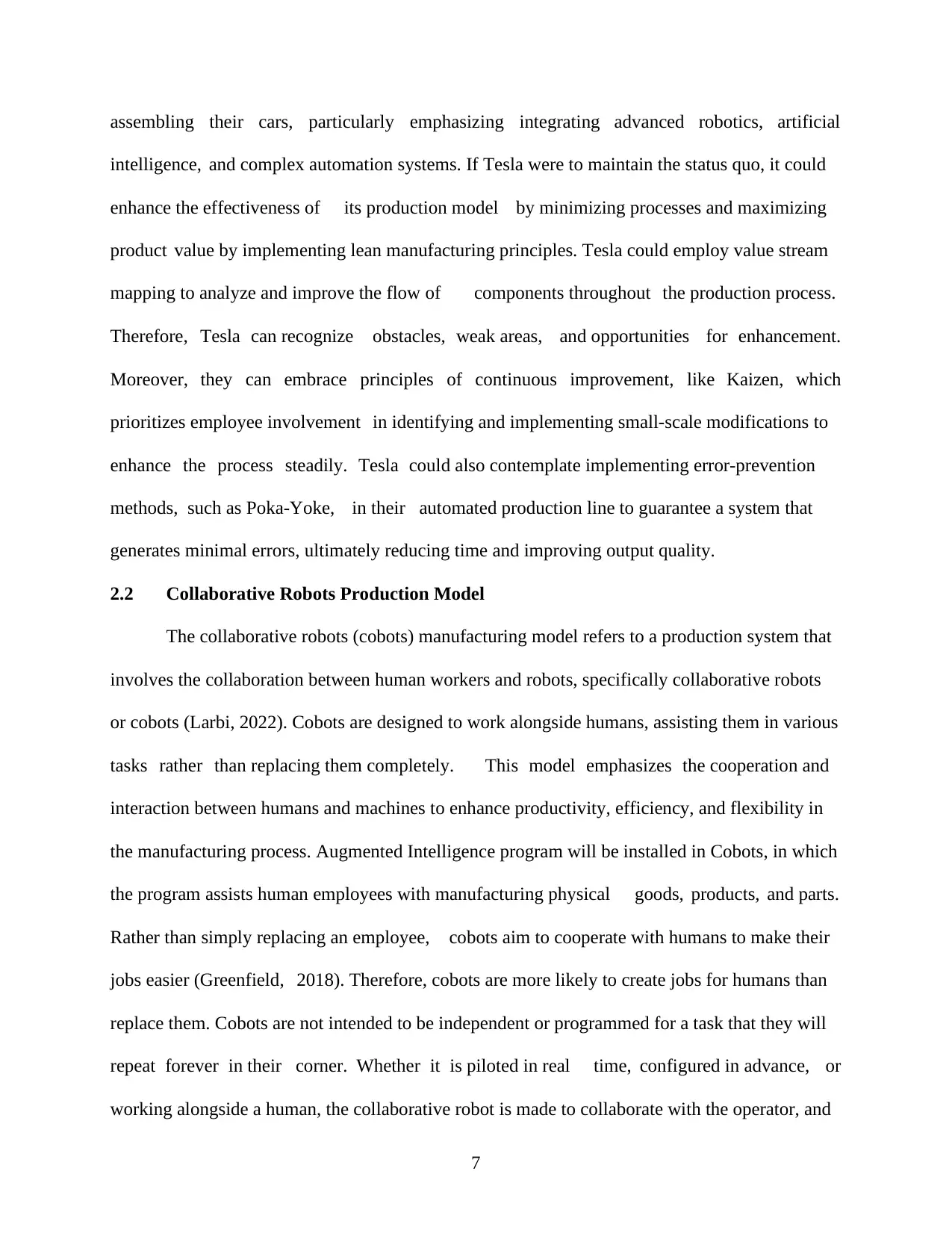
assembling their cars, particularly emphasizing integrating advanced robotics, artificial
intelligence, and complex automation systems. If Tesla were to maintain the status quo, it could
enhance the effectiveness of its production model by minimizing processes and maximizing
product value by implementing lean manufacturing principles. Tesla could employ value stream
mapping to analyze and improve the flow of components throughout the production process.
Therefore, Tesla can recognize obstacles, weak areas, and opportunities for enhancement.
Moreover, they can embrace principles of continuous improvement, like Kaizen, which
prioritizes employee involvement in identifying and implementing small-scale modifications to
enhance the process steadily. Tesla could also contemplate implementing error-prevention
methods, such as Poka-Yoke, in their automated production line to guarantee a system that
generates minimal errors, ultimately reducing time and improving output quality.
2.2 Collaborative Robots Production Model
The collaborative robots (cobots) manufacturing model refers to a production system that
involves the collaboration between human workers and robots, specifically collaborative robots
or cobots (Larbi, 2022). Cobots are designed to work alongside humans, assisting them in various
tasks rather than replacing them completely. This model emphasizes the cooperation and
interaction between humans and machines to enhance productivity, efficiency, and flexibility in
the manufacturing process. Augmented Intelligence program will be installed in Cobots, in which
the program assists human employees with manufacturing physical goods, products, and parts.
Rather than simply replacing an employee, cobots aim to cooperate with humans to make their
jobs easier (Greenfield, 2018). Therefore, cobots are more likely to create jobs for humans than
replace them. Cobots are not intended to be independent or programmed for a task that they will
repeat forever in their corner. Whether it is piloted in real time, configured in advance, or
working alongside a human, the collaborative robot is made to collaborate with the operator, and
7
intelligence, and complex automation systems. If Tesla were to maintain the status quo, it could
enhance the effectiveness of its production model by minimizing processes and maximizing
product value by implementing lean manufacturing principles. Tesla could employ value stream
mapping to analyze and improve the flow of components throughout the production process.
Therefore, Tesla can recognize obstacles, weak areas, and opportunities for enhancement.
Moreover, they can embrace principles of continuous improvement, like Kaizen, which
prioritizes employee involvement in identifying and implementing small-scale modifications to
enhance the process steadily. Tesla could also contemplate implementing error-prevention
methods, such as Poka-Yoke, in their automated production line to guarantee a system that
generates minimal errors, ultimately reducing time and improving output quality.
2.2 Collaborative Robots Production Model
The collaborative robots (cobots) manufacturing model refers to a production system that
involves the collaboration between human workers and robots, specifically collaborative robots
or cobots (Larbi, 2022). Cobots are designed to work alongside humans, assisting them in various
tasks rather than replacing them completely. This model emphasizes the cooperation and
interaction between humans and machines to enhance productivity, efficiency, and flexibility in
the manufacturing process. Augmented Intelligence program will be installed in Cobots, in which
the program assists human employees with manufacturing physical goods, products, and parts.
Rather than simply replacing an employee, cobots aim to cooperate with humans to make their
jobs easier (Greenfield, 2018). Therefore, cobots are more likely to create jobs for humans than
replace them. Cobots are not intended to be independent or programmed for a task that they will
repeat forever in their corner. Whether it is piloted in real time, configured in advance, or
working alongside a human, the collaborative robot is made to collaborate with the operator, and
7
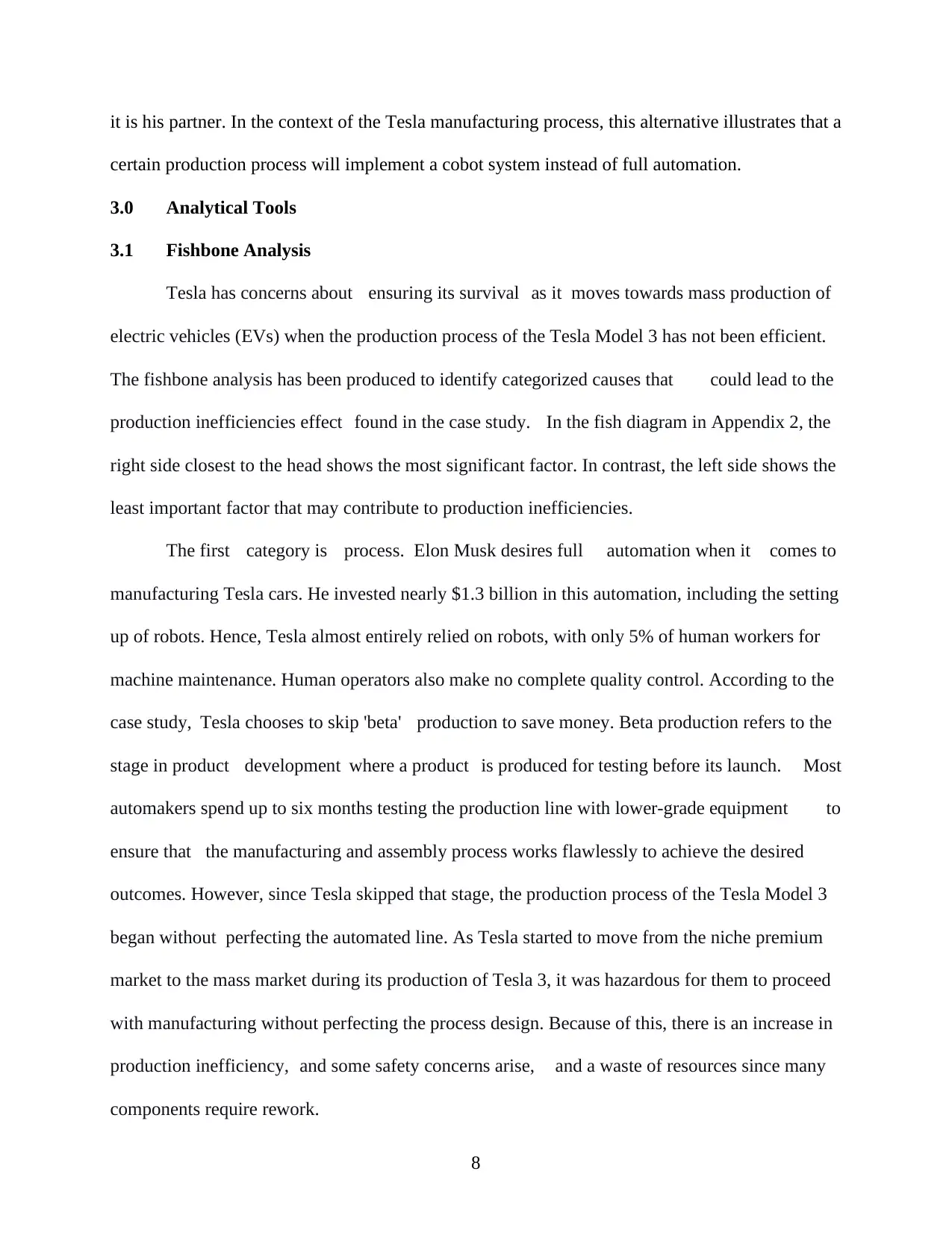
it is his partner. In the context of the Tesla manufacturing process, this alternative illustrates that a
certain production process will implement a cobot system instead of full automation.
3.0 Analytical Tools
3.1 Fishbone Analysis
Tesla has concerns about ensuring its survival as it moves towards mass production of
electric vehicles (EVs) when the production process of the Tesla Model 3 has not been efficient.
The fishbone analysis has been produced to identify categorized causes that could lead to the
production inefficiencies effect found in the case study. In the fish diagram in Appendix 2, the
right side closest to the head shows the most significant factor. In contrast, the left side shows the
least important factor that may contribute to production inefficiencies.
The first category is process. Elon Musk desires full automation when it comes to
manufacturing Tesla cars. He invested nearly $1.3 billion in this automation, including the setting
up of robots. Hence, Tesla almost entirely relied on robots, with only 5% of human workers for
machine maintenance. Human operators also make no complete quality control. According to the
case study, Tesla chooses to skip 'beta' production to save money. Beta production refers to the
stage in product development where a product is produced for testing before its launch. Most
automakers spend up to six months testing the production line with lower-grade equipment to
ensure that the manufacturing and assembly process works flawlessly to achieve the desired
outcomes. However, since Tesla skipped that stage, the production process of the Tesla Model 3
began without perfecting the automated line. As Tesla started to move from the niche premium
market to the mass market during its production of Tesla 3, it was hazardous for them to proceed
with manufacturing without perfecting the process design. Because of this, there is an increase in
production inefficiency, and some safety concerns arise, and a waste of resources since many
components require rework.
8
certain production process will implement a cobot system instead of full automation.
3.0 Analytical Tools
3.1 Fishbone Analysis
Tesla has concerns about ensuring its survival as it moves towards mass production of
electric vehicles (EVs) when the production process of the Tesla Model 3 has not been efficient.
The fishbone analysis has been produced to identify categorized causes that could lead to the
production inefficiencies effect found in the case study. In the fish diagram in Appendix 2, the
right side closest to the head shows the most significant factor. In contrast, the left side shows the
least important factor that may contribute to production inefficiencies.
The first category is process. Elon Musk desires full automation when it comes to
manufacturing Tesla cars. He invested nearly $1.3 billion in this automation, including the setting
up of robots. Hence, Tesla almost entirely relied on robots, with only 5% of human workers for
machine maintenance. Human operators also make no complete quality control. According to the
case study, Tesla chooses to skip 'beta' production to save money. Beta production refers to the
stage in product development where a product is produced for testing before its launch. Most
automakers spend up to six months testing the production line with lower-grade equipment to
ensure that the manufacturing and assembly process works flawlessly to achieve the desired
outcomes. However, since Tesla skipped that stage, the production process of the Tesla Model 3
began without perfecting the automated line. As Tesla started to move from the niche premium
market to the mass market during its production of Tesla 3, it was hazardous for them to proceed
with manufacturing without perfecting the process design. Because of this, there is an increase in
production inefficiency, and some safety concerns arise, and a waste of resources since many
components require rework.
8
Secure Best Marks with AI Grader
Need help grading? Try our AI Grader for instant feedback on your assignments.

As robots mainly produced Model 3, the essential category that Tesla has to look into is
technologies and equipment. It was stated that the automated machines and Tesla technologies
frequently faced technological glitches. Machines were malfunctioning, parts were misaligned,
and the software was crashing. Tesla temporarily stopped production in late February and April to
address bottlenecks in their highly automated factories. The over-reliance on technology has
caused delays in the production of Model 3. There is inconsistent supervision of machines which
causes them to discover defects late. According to a Tesla engineer, the automated lines cannot
operate at total capacity, resulting in a need to halt the entire process if any issue arises.
(Kolodny, 2018). Late identification of defects leads to unreliable output & inconsistency in
product specifications. Elon Musk acknowledged that the excessive reliance on automation at
Tesla was a mistake and expressed the undervaluation of human involvement in the operations.
For Tesla's workforce, there is low reliance on workers when it comes to the
manufacturing and assembly processes of Tesla. It has been identified that Tesla suffered from a
shortage of skilled technical workers. According to Kolodny (2018), Tesla employees also
revealed that the quality control workers lacked experience, resulting in some batteries being
shipped from the factory with potentially severe defects. Koldony (2018) added that many of the
company's quality control workers are relatively inexperienced, make sloppy calculations and do
not even recognize when looking at flaws during production. When production is stopped, Tesla
operators have difficulty identifying the fault due to a lack of technical proficiency. There is
inadequate training in quality control as they rely heavily on automation. Due to these factors,
Tesla must halt production for quality control investigation. When the automated line faced
problems, Tesla went from automation to making some batteries by hand and needed manpower
from its supplier to aid them with manual assembly (Kolodny, 2018). The unforeseen pauses in
9
technologies and equipment. It was stated that the automated machines and Tesla technologies
frequently faced technological glitches. Machines were malfunctioning, parts were misaligned,
and the software was crashing. Tesla temporarily stopped production in late February and April to
address bottlenecks in their highly automated factories. The over-reliance on technology has
caused delays in the production of Model 3. There is inconsistent supervision of machines which
causes them to discover defects late. According to a Tesla engineer, the automated lines cannot
operate at total capacity, resulting in a need to halt the entire process if any issue arises.
(Kolodny, 2018). Late identification of defects leads to unreliable output & inconsistency in
product specifications. Elon Musk acknowledged that the excessive reliance on automation at
Tesla was a mistake and expressed the undervaluation of human involvement in the operations.
For Tesla's workforce, there is low reliance on workers when it comes to the
manufacturing and assembly processes of Tesla. It has been identified that Tesla suffered from a
shortage of skilled technical workers. According to Kolodny (2018), Tesla employees also
revealed that the quality control workers lacked experience, resulting in some batteries being
shipped from the factory with potentially severe defects. Koldony (2018) added that many of the
company's quality control workers are relatively inexperienced, make sloppy calculations and do
not even recognize when looking at flaws during production. When production is stopped, Tesla
operators have difficulty identifying the fault due to a lack of technical proficiency. There is
inadequate training in quality control as they rely heavily on automation. Due to these factors,
Tesla must halt production for quality control investigation. When the automated line faced
problems, Tesla went from automation to making some batteries by hand and needed manpower
from its supplier to aid them with manual assembly (Kolodny, 2018). The unforeseen pauses in
9
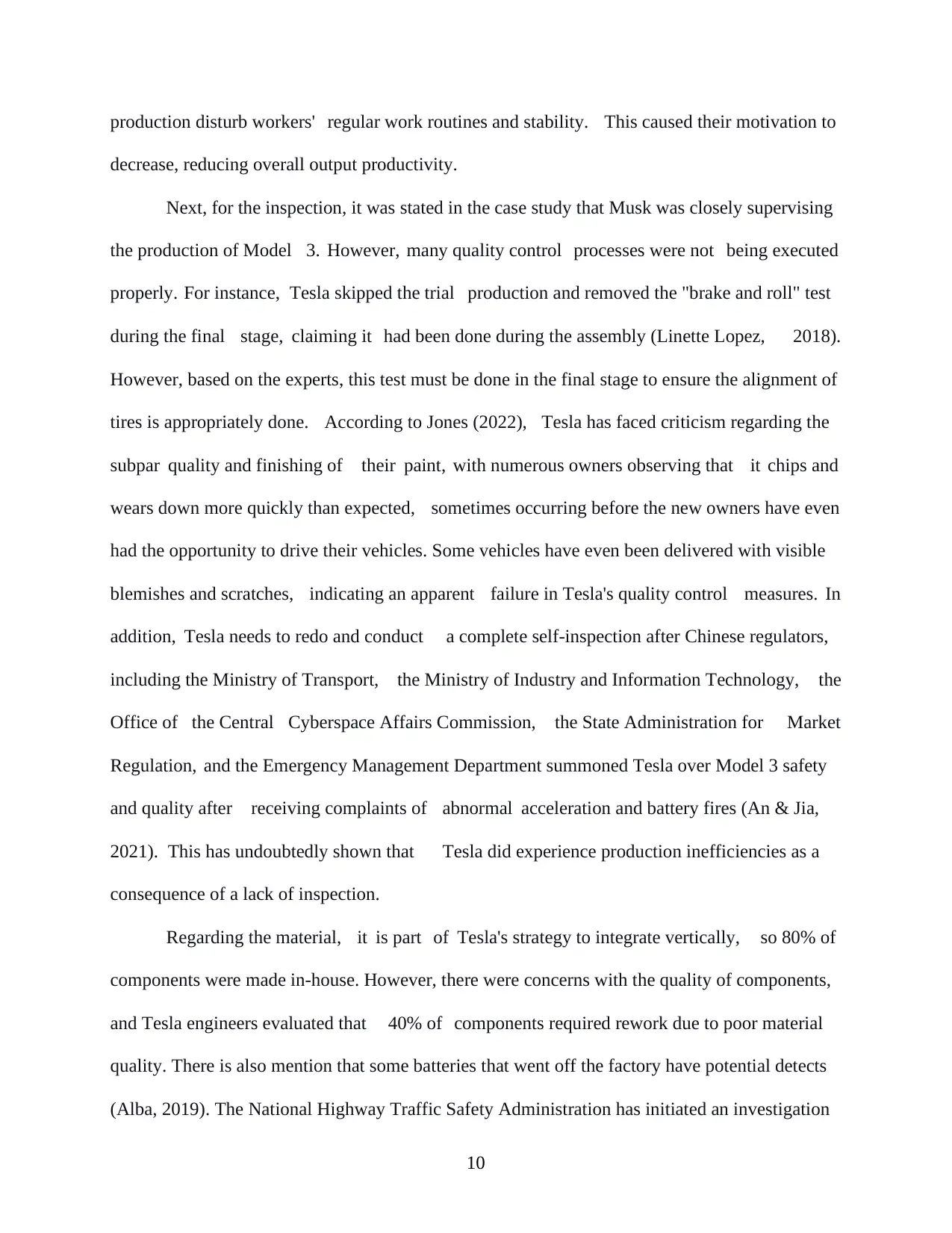
production disturb workers' regular work routines and stability. This caused their motivation to
decrease, reducing overall output productivity.
Next, for the inspection, it was stated in the case study that Musk was closely supervising
the production of Model 3. However, many quality control processes were not being executed
properly. For instance, Tesla skipped the trial production and removed the "brake and roll" test
during the final stage, claiming it had been done during the assembly (Linette Lopez, 2018).
However, based on the experts, this test must be done in the final stage to ensure the alignment of
tires is appropriately done. According to Jones (2022), Tesla has faced criticism regarding the
subpar quality and finishing of their paint, with numerous owners observing that it chips and
wears down more quickly than expected, sometimes occurring before the new owners have even
had the opportunity to drive their vehicles. Some vehicles have even been delivered with visible
blemishes and scratches, indicating an apparent failure in Tesla's quality control measures. In
addition, Tesla needs to redo and conduct a complete self-inspection after Chinese regulators,
including the Ministry of Transport, the Ministry of Industry and Information Technology, the
Office of the Central Cyberspace Affairs Commission, the State Administration for Market
Regulation, and the Emergency Management Department summoned Tesla over Model 3 safety
and quality after receiving complaints of abnormal acceleration and battery fires (An & Jia,
2021). This has undoubtedly shown that Tesla did experience production inefficiencies as a
consequence of a lack of inspection.
Regarding the material, it is part of Tesla's strategy to integrate vertically, so 80% of
components were made in-house. However, there were concerns with the quality of components,
and Tesla engineers evaluated that 40% of components required rework due to poor material
quality. There is also mention that some batteries that went off the factory have potential detects
(Alba, 2019). The National Highway Traffic Safety Administration has initiated an investigation
10
decrease, reducing overall output productivity.
Next, for the inspection, it was stated in the case study that Musk was closely supervising
the production of Model 3. However, many quality control processes were not being executed
properly. For instance, Tesla skipped the trial production and removed the "brake and roll" test
during the final stage, claiming it had been done during the assembly (Linette Lopez, 2018).
However, based on the experts, this test must be done in the final stage to ensure the alignment of
tires is appropriately done. According to Jones (2022), Tesla has faced criticism regarding the
subpar quality and finishing of their paint, with numerous owners observing that it chips and
wears down more quickly than expected, sometimes occurring before the new owners have even
had the opportunity to drive their vehicles. Some vehicles have even been delivered with visible
blemishes and scratches, indicating an apparent failure in Tesla's quality control measures. In
addition, Tesla needs to redo and conduct a complete self-inspection after Chinese regulators,
including the Ministry of Transport, the Ministry of Industry and Information Technology, the
Office of the Central Cyberspace Affairs Commission, the State Administration for Market
Regulation, and the Emergency Management Department summoned Tesla over Model 3 safety
and quality after receiving complaints of abnormal acceleration and battery fires (An & Jia,
2021). This has undoubtedly shown that Tesla did experience production inefficiencies as a
consequence of a lack of inspection.
Regarding the material, it is part of Tesla's strategy to integrate vertically, so 80% of
components were made in-house. However, there were concerns with the quality of components,
and Tesla engineers evaluated that 40% of components required rework due to poor material
quality. There is also mention that some batteries that went off the factory have potential detects
(Alba, 2019). The National Highway Traffic Safety Administration has initiated an investigation
10

into potential battery defects in Tesla sedans following reports of some vehicles catching fire
without apparent cause, which adds to the growing safety concerns. When one of its suppliers
unexpectedly withdrew, Tesla faced disruptions in its supply chain. Elon Musk revealed that the
company's Fremont plant in California temporarily closed for two days due to part shortages
(Reuters, 2021). Since there is a lack of quality control and rework of components, there is
inconsistency in material specifications.
Tesla should prioritize streamlining process designs to involve the human touch,
improving technology to enable human supervision, and strengthening quality control inspection
to enhance production efficiencies. By incorporating these changes, Tesla can address their
current challenges and improve production efficiency.
3.2 Critical Success Factors
3.2.1 Manufacturing Efficiency and Scalable Capacity
Manufacturing efficiency is crucial for the success of automotive manufacturers as it
involves optimizing every aspect of the production process, from material sourcing and
procurement to assembly and quality control. A study by Habidin et al. (2017) emphasizes the
importance for automotive manufacturers to sustain the manufacturing process in order to
manage raw material usage effectively. The automotive industry operates on short cycle times,
and even a minor machine downtime can lead to a significant number of cars being delayed
(Gellendin, 2022). Even advanced manufacturing facilities like Gigafactories, known for their
automation technologies, have faced labour shortages, unexpected machine downtime, and
operational issues, resulting in lower-than-expected output (Hensly et al., 2022). However,
improved factory operating efficiency and vehicle design have contributed to higher quality and
productivity, narrowing the competitive gap (National Research Council, 1992). Furthermore, a
scalable manufacturing process is considered cost-effective as it enables companies to optimize
11
without apparent cause, which adds to the growing safety concerns. When one of its suppliers
unexpectedly withdrew, Tesla faced disruptions in its supply chain. Elon Musk revealed that the
company's Fremont plant in California temporarily closed for two days due to part shortages
(Reuters, 2021). Since there is a lack of quality control and rework of components, there is
inconsistency in material specifications.
Tesla should prioritize streamlining process designs to involve the human touch,
improving technology to enable human supervision, and strengthening quality control inspection
to enhance production efficiencies. By incorporating these changes, Tesla can address their
current challenges and improve production efficiency.
3.2 Critical Success Factors
3.2.1 Manufacturing Efficiency and Scalable Capacity
Manufacturing efficiency is crucial for the success of automotive manufacturers as it
involves optimizing every aspect of the production process, from material sourcing and
procurement to assembly and quality control. A study by Habidin et al. (2017) emphasizes the
importance for automotive manufacturers to sustain the manufacturing process in order to
manage raw material usage effectively. The automotive industry operates on short cycle times,
and even a minor machine downtime can lead to a significant number of cars being delayed
(Gellendin, 2022). Even advanced manufacturing facilities like Gigafactories, known for their
automation technologies, have faced labour shortages, unexpected machine downtime, and
operational issues, resulting in lower-than-expected output (Hensly et al., 2022). However,
improved factory operating efficiency and vehicle design have contributed to higher quality and
productivity, narrowing the competitive gap (National Research Council, 1992). Furthermore, a
scalable manufacturing process is considered cost-effective as it enables companies to optimize
11
Paraphrase This Document
Need a fresh take? Get an instant paraphrase of this document with our AI Paraphraser
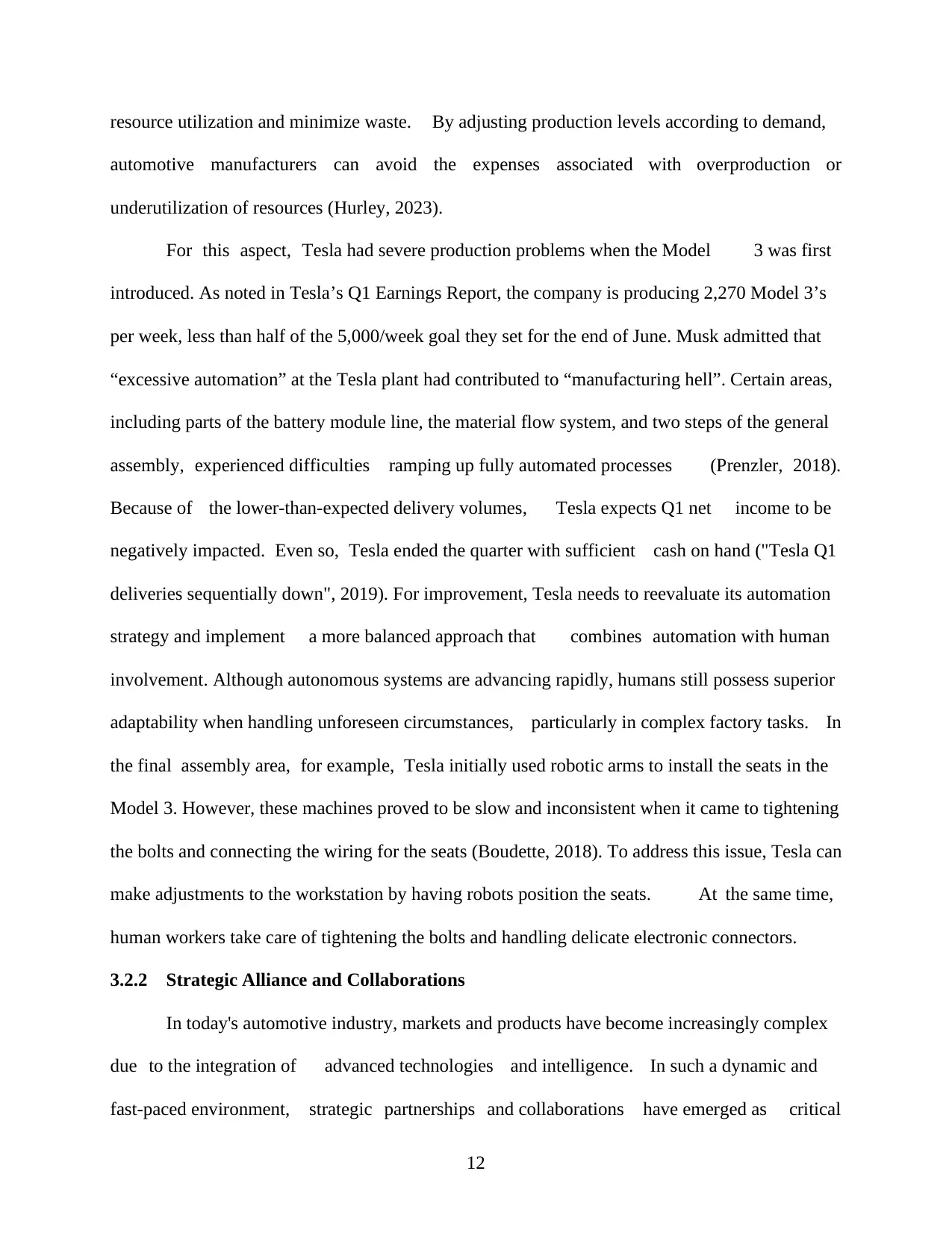
resource utilization and minimize waste. By adjusting production levels according to demand,
automotive manufacturers can avoid the expenses associated with overproduction or
underutilization of resources (Hurley, 2023).
For this aspect, Tesla had severe production problems when the Model 3 was first
introduced. As noted in Tesla’s Q1 Earnings Report, the company is producing 2,270 Model 3’s
per week, less than half of the 5,000/week goal they set for the end of June. Musk admitted that
“excessive automation” at the Tesla plant had contributed to “manufacturing hell”. Certain areas,
including parts of the battery module line, the material flow system, and two steps of the general
assembly, experienced difficulties ramping up fully automated processes (Prenzler, 2018).
Because of the lower-than-expected delivery volumes, Tesla expects Q1 net income to be
negatively impacted. Even so, Tesla ended the quarter with sufficient cash on hand ("Tesla Q1
deliveries sequentially down", 2019). For improvement, Tesla needs to reevaluate its automation
strategy and implement a more balanced approach that combines automation with human
involvement. Although autonomous systems are advancing rapidly, humans still possess superior
adaptability when handling unforeseen circumstances, particularly in complex factory tasks. In
the final assembly area, for example, Tesla initially used robotic arms to install the seats in the
Model 3. However, these machines proved to be slow and inconsistent when it came to tightening
the bolts and connecting the wiring for the seats (Boudette, 2018). To address this issue, Tesla can
make adjustments to the workstation by having robots position the seats. At the same time,
human workers take care of tightening the bolts and handling delicate electronic connectors.
3.2.2 Strategic Alliance and Collaborations
In today's automotive industry, markets and products have become increasingly complex
due to the integration of advanced technologies and intelligence. In such a dynamic and
fast-paced environment, strategic partnerships and collaborations have emerged as critical
12
automotive manufacturers can avoid the expenses associated with overproduction or
underutilization of resources (Hurley, 2023).
For this aspect, Tesla had severe production problems when the Model 3 was first
introduced. As noted in Tesla’s Q1 Earnings Report, the company is producing 2,270 Model 3’s
per week, less than half of the 5,000/week goal they set for the end of June. Musk admitted that
“excessive automation” at the Tesla plant had contributed to “manufacturing hell”. Certain areas,
including parts of the battery module line, the material flow system, and two steps of the general
assembly, experienced difficulties ramping up fully automated processes (Prenzler, 2018).
Because of the lower-than-expected delivery volumes, Tesla expects Q1 net income to be
negatively impacted. Even so, Tesla ended the quarter with sufficient cash on hand ("Tesla Q1
deliveries sequentially down", 2019). For improvement, Tesla needs to reevaluate its automation
strategy and implement a more balanced approach that combines automation with human
involvement. Although autonomous systems are advancing rapidly, humans still possess superior
adaptability when handling unforeseen circumstances, particularly in complex factory tasks. In
the final assembly area, for example, Tesla initially used robotic arms to install the seats in the
Model 3. However, these machines proved to be slow and inconsistent when it came to tightening
the bolts and connecting the wiring for the seats (Boudette, 2018). To address this issue, Tesla can
make adjustments to the workstation by having robots position the seats. At the same time,
human workers take care of tightening the bolts and handling delicate electronic connectors.
3.2.2 Strategic Alliance and Collaborations
In today's automotive industry, markets and products have become increasingly complex
due to the integration of advanced technologies and intelligence. In such a dynamic and
fast-paced environment, strategic partnerships and collaborations have emerged as critical
12
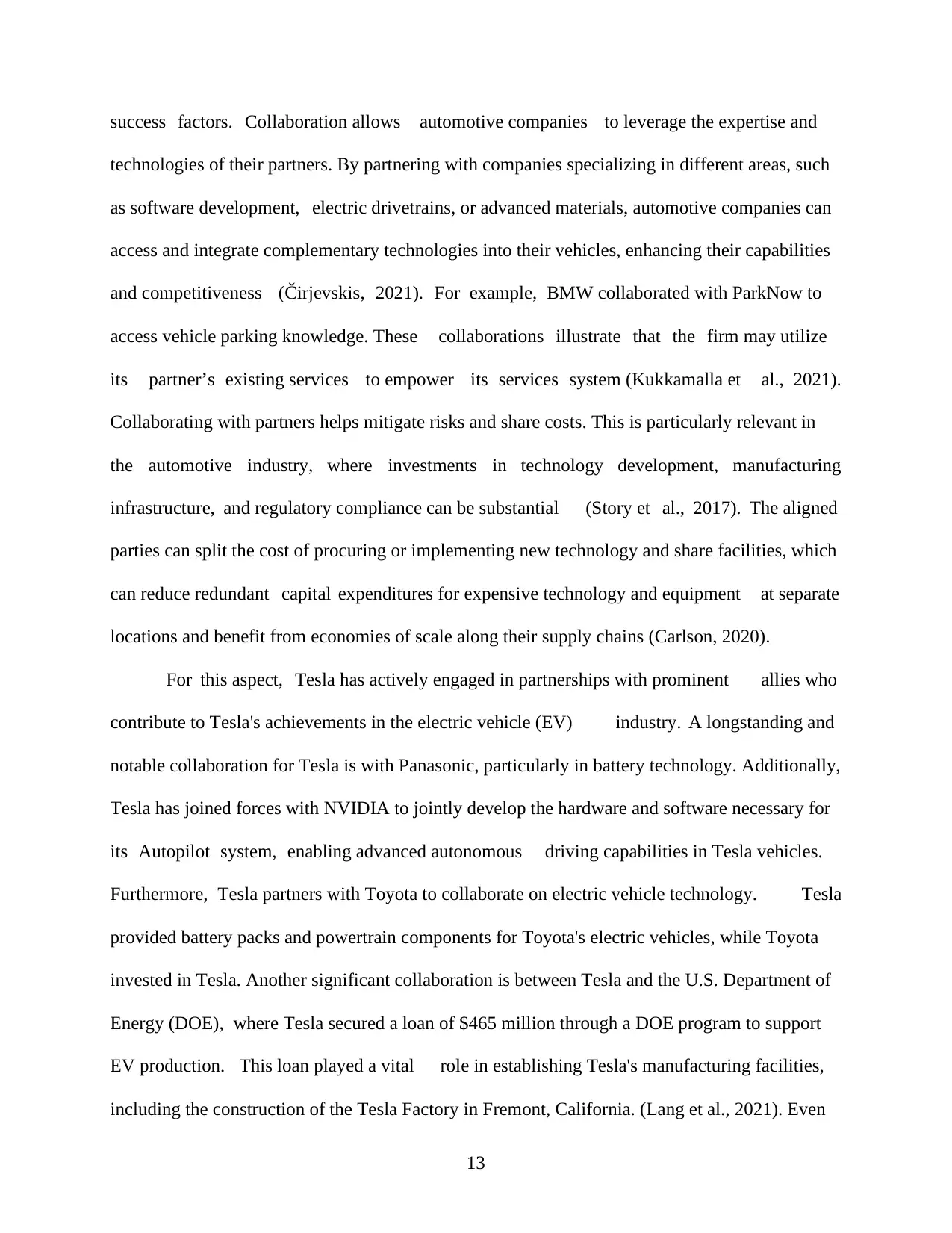
success factors. Collaboration allows automotive companies to leverage the expertise and
technologies of their partners. By partnering with companies specializing in different areas, such
as software development, electric drivetrains, or advanced materials, automotive companies can
access and integrate complementary technologies into their vehicles, enhancing their capabilities
and competitiveness (Čirjevskis, 2021). For example, BMW collaborated with ParkNow to
access vehicle parking knowledge. These collaborations illustrate that the firm may utilize
its partner’s existing services to empower its services system (Kukkamalla et al., 2021).
Collaborating with partners helps mitigate risks and share costs. This is particularly relevant in
the automotive industry, where investments in technology development, manufacturing
infrastructure, and regulatory compliance can be substantial (Story et al., 2017). The aligned
parties can split the cost of procuring or implementing new technology and share facilities, which
can reduce redundant capital expenditures for expensive technology and equipment at separate
locations and benefit from economies of scale along their supply chains (Carlson, 2020).
For this aspect, Tesla has actively engaged in partnerships with prominent allies who
contribute to Tesla's achievements in the electric vehicle (EV) industry. A longstanding and
notable collaboration for Tesla is with Panasonic, particularly in battery technology. Additionally,
Tesla has joined forces with NVIDIA to jointly develop the hardware and software necessary for
its Autopilot system, enabling advanced autonomous driving capabilities in Tesla vehicles.
Furthermore, Tesla partners with Toyota to collaborate on electric vehicle technology. Tesla
provided battery packs and powertrain components for Toyota's electric vehicles, while Toyota
invested in Tesla. Another significant collaboration is between Tesla and the U.S. Department of
Energy (DOE), where Tesla secured a loan of $465 million through a DOE program to support
EV production. This loan played a vital role in establishing Tesla's manufacturing facilities,
including the construction of the Tesla Factory in Fremont, California. (Lang et al., 2021). Even
13
technologies of their partners. By partnering with companies specializing in different areas, such
as software development, electric drivetrains, or advanced materials, automotive companies can
access and integrate complementary technologies into their vehicles, enhancing their capabilities
and competitiveness (Čirjevskis, 2021). For example, BMW collaborated with ParkNow to
access vehicle parking knowledge. These collaborations illustrate that the firm may utilize
its partner’s existing services to empower its services system (Kukkamalla et al., 2021).
Collaborating with partners helps mitigate risks and share costs. This is particularly relevant in
the automotive industry, where investments in technology development, manufacturing
infrastructure, and regulatory compliance can be substantial (Story et al., 2017). The aligned
parties can split the cost of procuring or implementing new technology and share facilities, which
can reduce redundant capital expenditures for expensive technology and equipment at separate
locations and benefit from economies of scale along their supply chains (Carlson, 2020).
For this aspect, Tesla has actively engaged in partnerships with prominent allies who
contribute to Tesla's achievements in the electric vehicle (EV) industry. A longstanding and
notable collaboration for Tesla is with Panasonic, particularly in battery technology. Additionally,
Tesla has joined forces with NVIDIA to jointly develop the hardware and software necessary for
its Autopilot system, enabling advanced autonomous driving capabilities in Tesla vehicles.
Furthermore, Tesla partners with Toyota to collaborate on electric vehicle technology. Tesla
provided battery packs and powertrain components for Toyota's electric vehicles, while Toyota
invested in Tesla. Another significant collaboration is between Tesla and the U.S. Department of
Energy (DOE), where Tesla secured a loan of $465 million through a DOE program to support
EV production. This loan played a vital role in establishing Tesla's manufacturing facilities,
including the construction of the Tesla Factory in Fremont, California. (Lang et al., 2021). Even
13
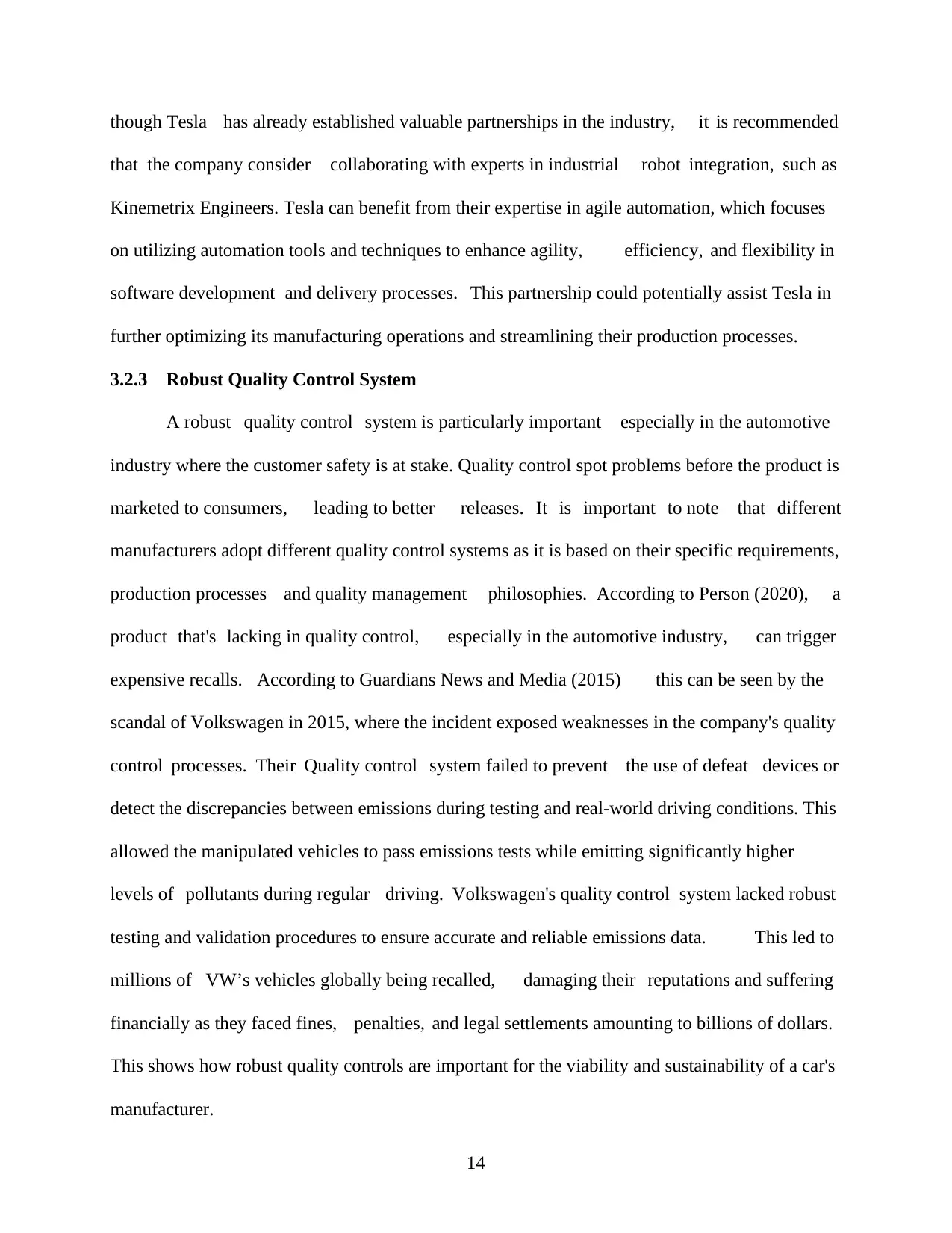
though Tesla has already established valuable partnerships in the industry, it is recommended
that the company consider collaborating with experts in industrial robot integration, such as
Kinemetrix Engineers. Tesla can benefit from their expertise in agile automation, which focuses
on utilizing automation tools and techniques to enhance agility, efficiency, and flexibility in
software development and delivery processes. This partnership could potentially assist Tesla in
further optimizing its manufacturing operations and streamlining their production processes.
3.2.3 Robust Quality Control System
A robust quality control system is particularly important especially in the automotive
industry where the customer safety is at stake. Quality control spot problems before the product is
marketed to consumers, leading to better releases. It is important to note that different
manufacturers adopt different quality control systems as it is based on their specific requirements,
production processes and quality management philosophies. According to Person (2020), a
product that's lacking in quality control, especially in the automotive industry, can trigger
expensive recalls. According to Guardians News and Media (2015) this can be seen by the
scandal of Volkswagen in 2015, where the incident exposed weaknesses in the company's quality
control processes. Their Quality control system failed to prevent the use of defeat devices or
detect the discrepancies between emissions during testing and real-world driving conditions. This
allowed the manipulated vehicles to pass emissions tests while emitting significantly higher
levels of pollutants during regular driving. Volkswagen's quality control system lacked robust
testing and validation procedures to ensure accurate and reliable emissions data. This led to
millions of VW’s vehicles globally being recalled, damaging their reputations and suffering
financially as they faced fines, penalties, and legal settlements amounting to billions of dollars.
This shows how robust quality controls are important for the viability and sustainability of a car's
manufacturer.
14
that the company consider collaborating with experts in industrial robot integration, such as
Kinemetrix Engineers. Tesla can benefit from their expertise in agile automation, which focuses
on utilizing automation tools and techniques to enhance agility, efficiency, and flexibility in
software development and delivery processes. This partnership could potentially assist Tesla in
further optimizing its manufacturing operations and streamlining their production processes.
3.2.3 Robust Quality Control System
A robust quality control system is particularly important especially in the automotive
industry where the customer safety is at stake. Quality control spot problems before the product is
marketed to consumers, leading to better releases. It is important to note that different
manufacturers adopt different quality control systems as it is based on their specific requirements,
production processes and quality management philosophies. According to Person (2020), a
product that's lacking in quality control, especially in the automotive industry, can trigger
expensive recalls. According to Guardians News and Media (2015) this can be seen by the
scandal of Volkswagen in 2015, where the incident exposed weaknesses in the company's quality
control processes. Their Quality control system failed to prevent the use of defeat devices or
detect the discrepancies between emissions during testing and real-world driving conditions. This
allowed the manipulated vehicles to pass emissions tests while emitting significantly higher
levels of pollutants during regular driving. Volkswagen's quality control system lacked robust
testing and validation procedures to ensure accurate and reliable emissions data. This led to
millions of VW’s vehicles globally being recalled, damaging their reputations and suffering
financially as they faced fines, penalties, and legal settlements amounting to billions of dollars.
This shows how robust quality controls are important for the viability and sustainability of a car's
manufacturer.
14
Secure Best Marks with AI Grader
Need help grading? Try our AI Grader for instant feedback on your assignments.
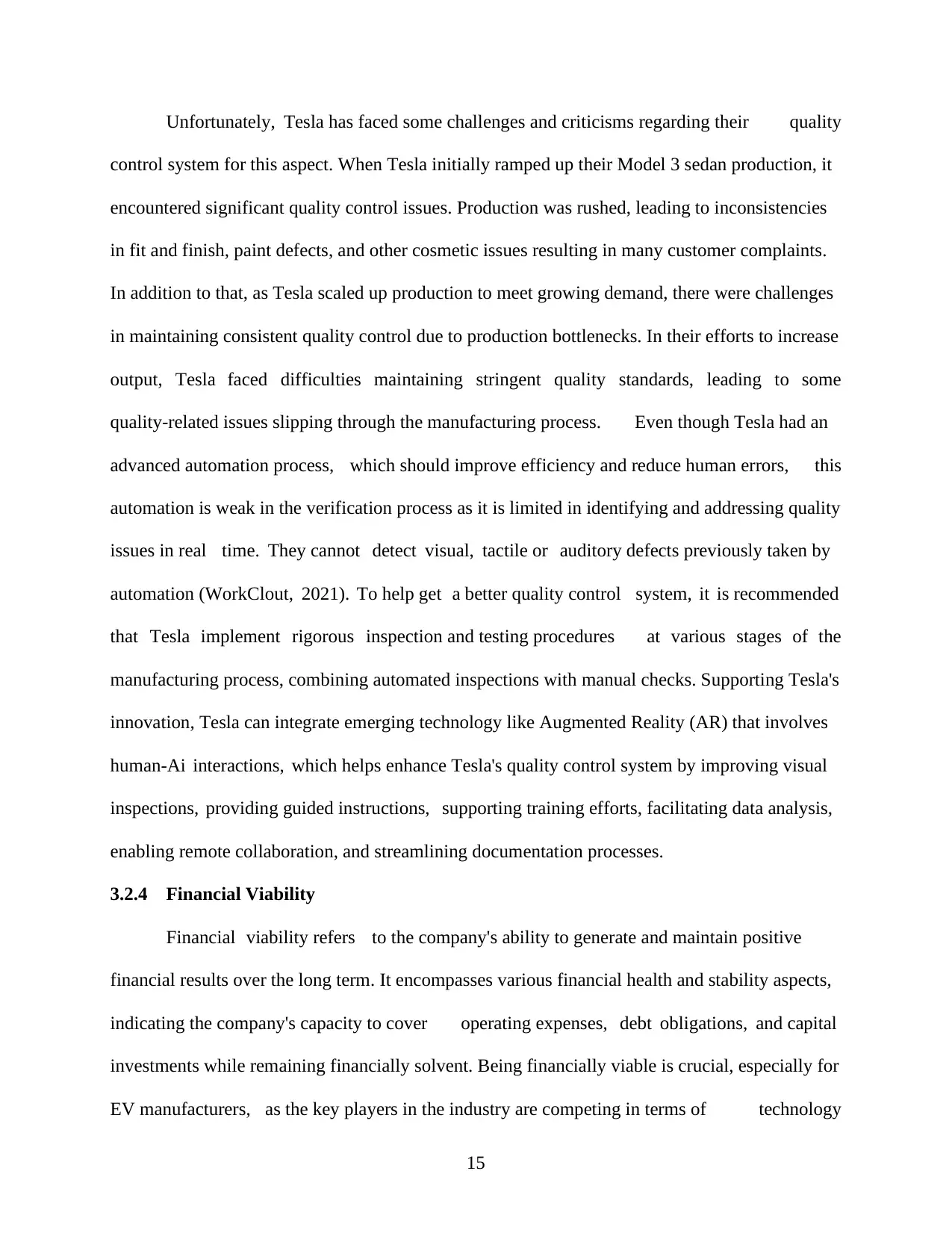
Unfortunately, Tesla has faced some challenges and criticisms regarding their quality
control system for this aspect. When Tesla initially ramped up their Model 3 sedan production, it
encountered significant quality control issues. Production was rushed, leading to inconsistencies
in fit and finish, paint defects, and other cosmetic issues resulting in many customer complaints.
In addition to that, as Tesla scaled up production to meet growing demand, there were challenges
in maintaining consistent quality control due to production bottlenecks. In their efforts to increase
output, Tesla faced difficulties maintaining stringent quality standards, leading to some
quality-related issues slipping through the manufacturing process. Even though Tesla had an
advanced automation process, which should improve efficiency and reduce human errors, this
automation is weak in the verification process as it is limited in identifying and addressing quality
issues in real time. They cannot detect visual, tactile or auditory defects previously taken by
automation (WorkClout, 2021). To help get a better quality control system, it is recommended
that Tesla implement rigorous inspection and testing procedures at various stages of the
manufacturing process, combining automated inspections with manual checks. Supporting Tesla's
innovation, Tesla can integrate emerging technology like Augmented Reality (AR) that involves
human-Ai interactions, which helps enhance Tesla's quality control system by improving visual
inspections, providing guided instructions, supporting training efforts, facilitating data analysis,
enabling remote collaboration, and streamlining documentation processes.
3.2.4 Financial Viability
Financial viability refers to the company's ability to generate and maintain positive
financial results over the long term. It encompasses various financial health and stability aspects,
indicating the company's capacity to cover operating expenses, debt obligations, and capital
investments while remaining financially solvent. Being financially viable is crucial, especially for
EV manufacturers, as the key players in the industry are competing in terms of technology
15
control system for this aspect. When Tesla initially ramped up their Model 3 sedan production, it
encountered significant quality control issues. Production was rushed, leading to inconsistencies
in fit and finish, paint defects, and other cosmetic issues resulting in many customer complaints.
In addition to that, as Tesla scaled up production to meet growing demand, there were challenges
in maintaining consistent quality control due to production bottlenecks. In their efforts to increase
output, Tesla faced difficulties maintaining stringent quality standards, leading to some
quality-related issues slipping through the manufacturing process. Even though Tesla had an
advanced automation process, which should improve efficiency and reduce human errors, this
automation is weak in the verification process as it is limited in identifying and addressing quality
issues in real time. They cannot detect visual, tactile or auditory defects previously taken by
automation (WorkClout, 2021). To help get a better quality control system, it is recommended
that Tesla implement rigorous inspection and testing procedures at various stages of the
manufacturing process, combining automated inspections with manual checks. Supporting Tesla's
innovation, Tesla can integrate emerging technology like Augmented Reality (AR) that involves
human-Ai interactions, which helps enhance Tesla's quality control system by improving visual
inspections, providing guided instructions, supporting training efforts, facilitating data analysis,
enabling remote collaboration, and streamlining documentation processes.
3.2.4 Financial Viability
Financial viability refers to the company's ability to generate and maintain positive
financial results over the long term. It encompasses various financial health and stability aspects,
indicating the company's capacity to cover operating expenses, debt obligations, and capital
investments while remaining financially solvent. Being financially viable is crucial, especially for
EV manufacturers, as the key players in the industry are competing in terms of technology
15
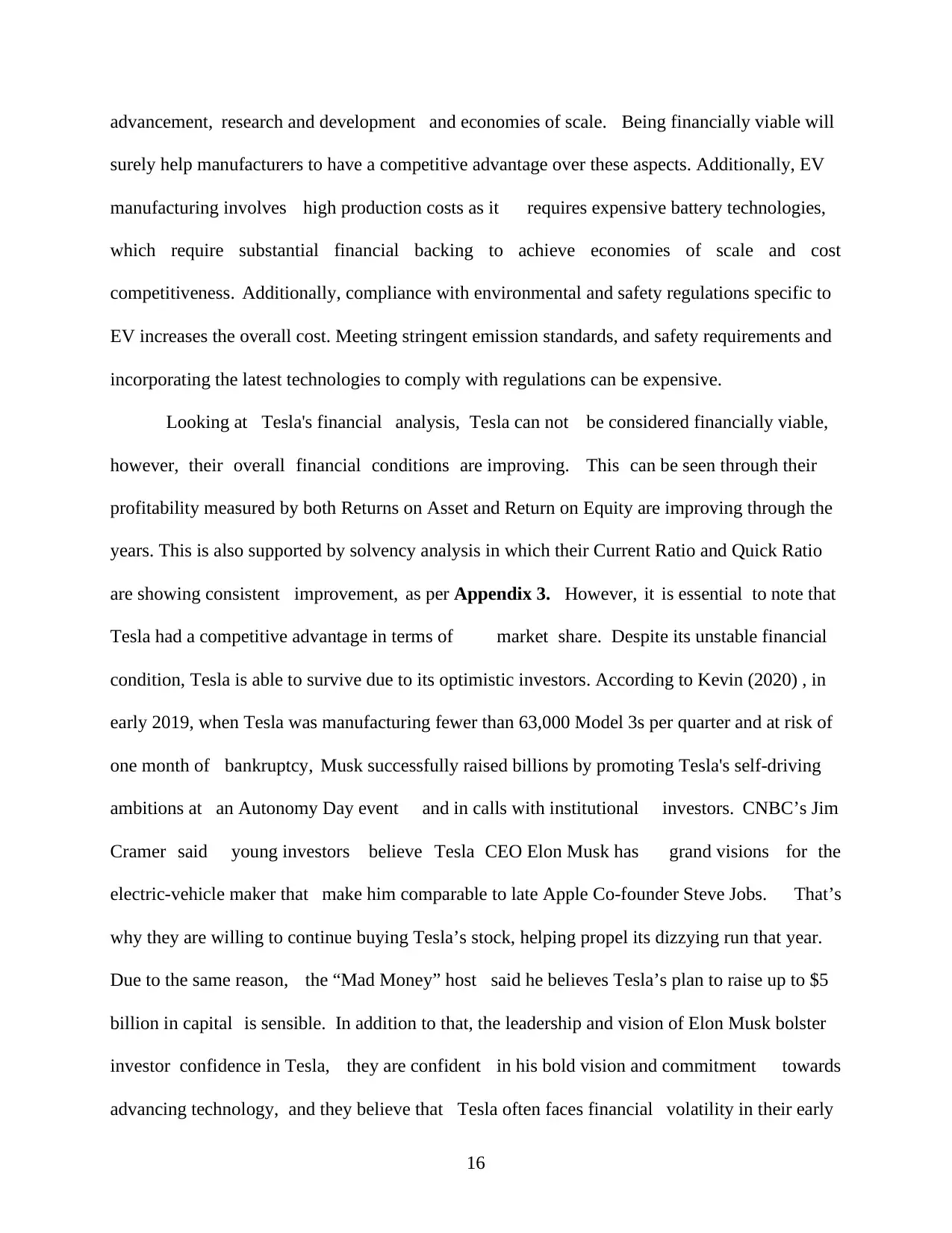
advancement, research and development and economies of scale. Being financially viable will
surely help manufacturers to have a competitive advantage over these aspects. Additionally, EV
manufacturing involves high production costs as it requires expensive battery technologies,
which require substantial financial backing to achieve economies of scale and cost
competitiveness. Additionally, compliance with environmental and safety regulations specific to
EV increases the overall cost. Meeting stringent emission standards, and safety requirements and
incorporating the latest technologies to comply with regulations can be expensive.
Looking at Tesla's financial analysis, Tesla can not be considered financially viable,
however, their overall financial conditions are improving. This can be seen through their
profitability measured by both Returns on Asset and Return on Equity are improving through the
years. This is also supported by solvency analysis in which their Current Ratio and Quick Ratio
are showing consistent improvement, as per Appendix 3. However, it is essential to note that
Tesla had a competitive advantage in terms of market share. Despite its unstable financial
condition, Tesla is able to survive due to its optimistic investors. According to Kevin (2020) , in
early 2019, when Tesla was manufacturing fewer than 63,000 Model 3s per quarter and at risk of
one month of bankruptcy, Musk successfully raised billions by promoting Tesla's self-driving
ambitions at an Autonomy Day event and in calls with institutional investors. CNBC’s Jim
Cramer said young investors believe Tesla CEO Elon Musk has grand visions for the
electric-vehicle maker that make him comparable to late Apple Co-founder Steve Jobs. That’s
why they are willing to continue buying Tesla’s stock, helping propel its dizzying run that year.
Due to the same reason, the “Mad Money” host said he believes Tesla’s plan to raise up to $5
billion in capital is sensible. In addition to that, the leadership and vision of Elon Musk bolster
investor confidence in Tesla, they are confident in his bold vision and commitment towards
advancing technology, and they believe that Tesla often faces financial volatility in their early
16
surely help manufacturers to have a competitive advantage over these aspects. Additionally, EV
manufacturing involves high production costs as it requires expensive battery technologies,
which require substantial financial backing to achieve economies of scale and cost
competitiveness. Additionally, compliance with environmental and safety regulations specific to
EV increases the overall cost. Meeting stringent emission standards, and safety requirements and
incorporating the latest technologies to comply with regulations can be expensive.
Looking at Tesla's financial analysis, Tesla can not be considered financially viable,
however, their overall financial conditions are improving. This can be seen through their
profitability measured by both Returns on Asset and Return on Equity are improving through the
years. This is also supported by solvency analysis in which their Current Ratio and Quick Ratio
are showing consistent improvement, as per Appendix 3. However, it is essential to note that
Tesla had a competitive advantage in terms of market share. Despite its unstable financial
condition, Tesla is able to survive due to its optimistic investors. According to Kevin (2020) , in
early 2019, when Tesla was manufacturing fewer than 63,000 Model 3s per quarter and at risk of
one month of bankruptcy, Musk successfully raised billions by promoting Tesla's self-driving
ambitions at an Autonomy Day event and in calls with institutional investors. CNBC’s Jim
Cramer said young investors believe Tesla CEO Elon Musk has grand visions for the
electric-vehicle maker that make him comparable to late Apple Co-founder Steve Jobs. That’s
why they are willing to continue buying Tesla’s stock, helping propel its dizzying run that year.
Due to the same reason, the “Mad Money” host said he believes Tesla’s plan to raise up to $5
billion in capital is sensible. In addition to that, the leadership and vision of Elon Musk bolster
investor confidence in Tesla, they are confident in his bold vision and commitment towards
advancing technology, and they believe that Tesla often faces financial volatility in their early
16
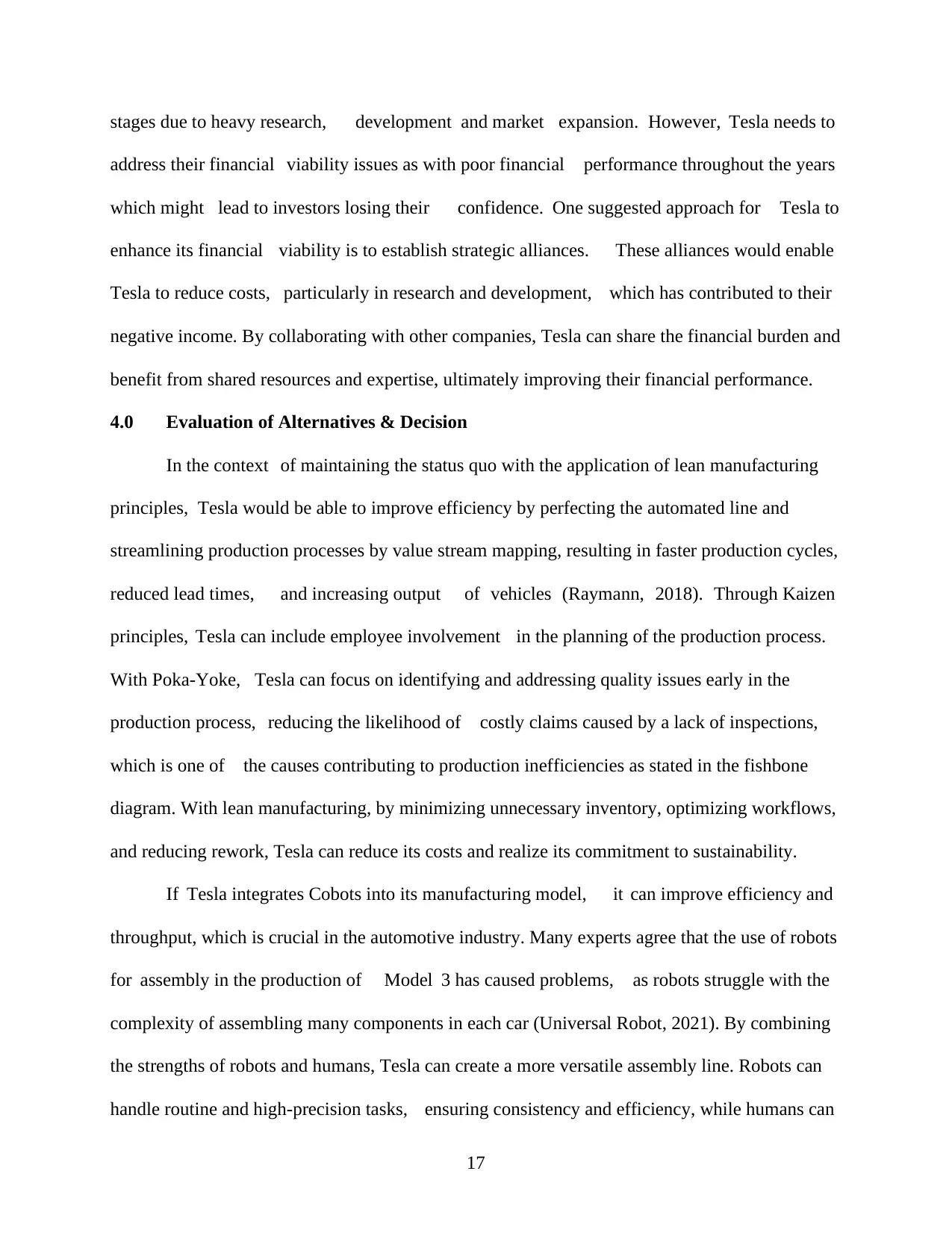
stages due to heavy research, development and market expansion. However, Tesla needs to
address their financial viability issues as with poor financial performance throughout the years
which might lead to investors losing their confidence. One suggested approach for Tesla to
enhance its financial viability is to establish strategic alliances. These alliances would enable
Tesla to reduce costs, particularly in research and development, which has contributed to their
negative income. By collaborating with other companies, Tesla can share the financial burden and
benefit from shared resources and expertise, ultimately improving their financial performance.
4.0 Evaluation of Alternatives & Decision
In the context of maintaining the status quo with the application of lean manufacturing
principles, Tesla would be able to improve efficiency by perfecting the automated line and
streamlining production processes by value stream mapping, resulting in faster production cycles,
reduced lead times, and increasing output of vehicles (Raymann, 2018). Through Kaizen
principles, Tesla can include employee involvement in the planning of the production process.
With Poka-Yoke, Tesla can focus on identifying and addressing quality issues early in the
production process, reducing the likelihood of costly claims caused by a lack of inspections,
which is one of the causes contributing to production inefficiencies as stated in the fishbone
diagram. With lean manufacturing, by minimizing unnecessary inventory, optimizing workflows,
and reducing rework, Tesla can reduce its costs and realize its commitment to sustainability.
If Tesla integrates Cobots into its manufacturing model, it can improve efficiency and
throughput, which is crucial in the automotive industry. Many experts agree that the use of robots
for assembly in the production of Model 3 has caused problems, as robots struggle with the
complexity of assembling many components in each car (Universal Robot, 2021). By combining
the strengths of robots and humans, Tesla can create a more versatile assembly line. Robots can
handle routine and high-precision tasks, ensuring consistency and efficiency, while humans can
17
address their financial viability issues as with poor financial performance throughout the years
which might lead to investors losing their confidence. One suggested approach for Tesla to
enhance its financial viability is to establish strategic alliances. These alliances would enable
Tesla to reduce costs, particularly in research and development, which has contributed to their
negative income. By collaborating with other companies, Tesla can share the financial burden and
benefit from shared resources and expertise, ultimately improving their financial performance.
4.0 Evaluation of Alternatives & Decision
In the context of maintaining the status quo with the application of lean manufacturing
principles, Tesla would be able to improve efficiency by perfecting the automated line and
streamlining production processes by value stream mapping, resulting in faster production cycles,
reduced lead times, and increasing output of vehicles (Raymann, 2018). Through Kaizen
principles, Tesla can include employee involvement in the planning of the production process.
With Poka-Yoke, Tesla can focus on identifying and addressing quality issues early in the
production process, reducing the likelihood of costly claims caused by a lack of inspections,
which is one of the causes contributing to production inefficiencies as stated in the fishbone
diagram. With lean manufacturing, by minimizing unnecessary inventory, optimizing workflows,
and reducing rework, Tesla can reduce its costs and realize its commitment to sustainability.
If Tesla integrates Cobots into its manufacturing model, it can improve efficiency and
throughput, which is crucial in the automotive industry. Many experts agree that the use of robots
for assembly in the production of Model 3 has caused problems, as robots struggle with the
complexity of assembling many components in each car (Universal Robot, 2021). By combining
the strengths of robots and humans, Tesla can create a more versatile assembly line. Robots can
handle routine and high-precision tasks, ensuring consistency and efficiency, while humans can
17
Paraphrase This Document
Need a fresh take? Get an instant paraphrase of this document with our AI Paraphraser

intervene and use their problem-solving skills when unexpected issues arise. This collaboration
allows Tesla to overcome bottlenecks and resolve problems efficiently. Human involvement also
addresses the issue of diminishing motivation identified in the fishbone analysis. Cobots
recognize workers' contributions, monitor robots, and allow workers to see the direct impact of
their work on the final product. Furthermore, Cobots can be easily programmed and
reprogrammed for different tasks, enabling quick adaptation to changes in product design or
manufacturing outputs. This flexibility enhances agility and responsiveness, contributing to
Tesla's ability to achieve scalable manufacturing processes, which is a critical success factor. In
addition, as quality control is crucial in the automotive industry, Cobot enhances it by enabling
humans to perform detailed inspections. Humans have a superior sensory perception to detect
anomalies, subtle variations, or defects, while machines are limited to following pre-programmed
instructions. Effective quality control can help Tesla reduce the risk of faulty products reaching
customers, avoiding bottlenecks caused by rework. Investing in Cobots benefits Tesla by
streamlining manufacturing, reducing costs, and increasing productivity. Cobots work alongside
humans, adding flexibility to the production line, and leading to improved profit margins. With
higher productivity, Tesla can maximize revenue without significant cost increases, keeping EV
cars affordable for consumers and ensuring long-term growth and competitiveness.
Based on the evaluation of both alternatives, it is more favourable for Tesla to adopt the
Cobot manufacturing model. This decision stems from the ability of Cobots to address major
issues related to production bottlenecks caused by excessive reliance on automation. Tesla,
benefiting from its competitive market share driven by investor optimism and belief in its growth
potential, can successfully integrate Cobots. This integration would enhance manufacturing
efficiency and attract increased capital injection from investors. The adoption of Cobots is
viewed as a strategic move that can enhance Tesla's competitiveness and profitability. This model
18
allows Tesla to overcome bottlenecks and resolve problems efficiently. Human involvement also
addresses the issue of diminishing motivation identified in the fishbone analysis. Cobots
recognize workers' contributions, monitor robots, and allow workers to see the direct impact of
their work on the final product. Furthermore, Cobots can be easily programmed and
reprogrammed for different tasks, enabling quick adaptation to changes in product design or
manufacturing outputs. This flexibility enhances agility and responsiveness, contributing to
Tesla's ability to achieve scalable manufacturing processes, which is a critical success factor. In
addition, as quality control is crucial in the automotive industry, Cobot enhances it by enabling
humans to perform detailed inspections. Humans have a superior sensory perception to detect
anomalies, subtle variations, or defects, while machines are limited to following pre-programmed
instructions. Effective quality control can help Tesla reduce the risk of faulty products reaching
customers, avoiding bottlenecks caused by rework. Investing in Cobots benefits Tesla by
streamlining manufacturing, reducing costs, and increasing productivity. Cobots work alongside
humans, adding flexibility to the production line, and leading to improved profit margins. With
higher productivity, Tesla can maximize revenue without significant cost increases, keeping EV
cars affordable for consumers and ensuring long-term growth and competitiveness.
Based on the evaluation of both alternatives, it is more favourable for Tesla to adopt the
Cobot manufacturing model. This decision stems from the ability of Cobots to address major
issues related to production bottlenecks caused by excessive reliance on automation. Tesla,
benefiting from its competitive market share driven by investor optimism and belief in its growth
potential, can successfully integrate Cobots. This integration would enhance manufacturing
efficiency and attract increased capital injection from investors. The adoption of Cobots is
viewed as a strategic move that can enhance Tesla's competitiveness and profitability. This model
18
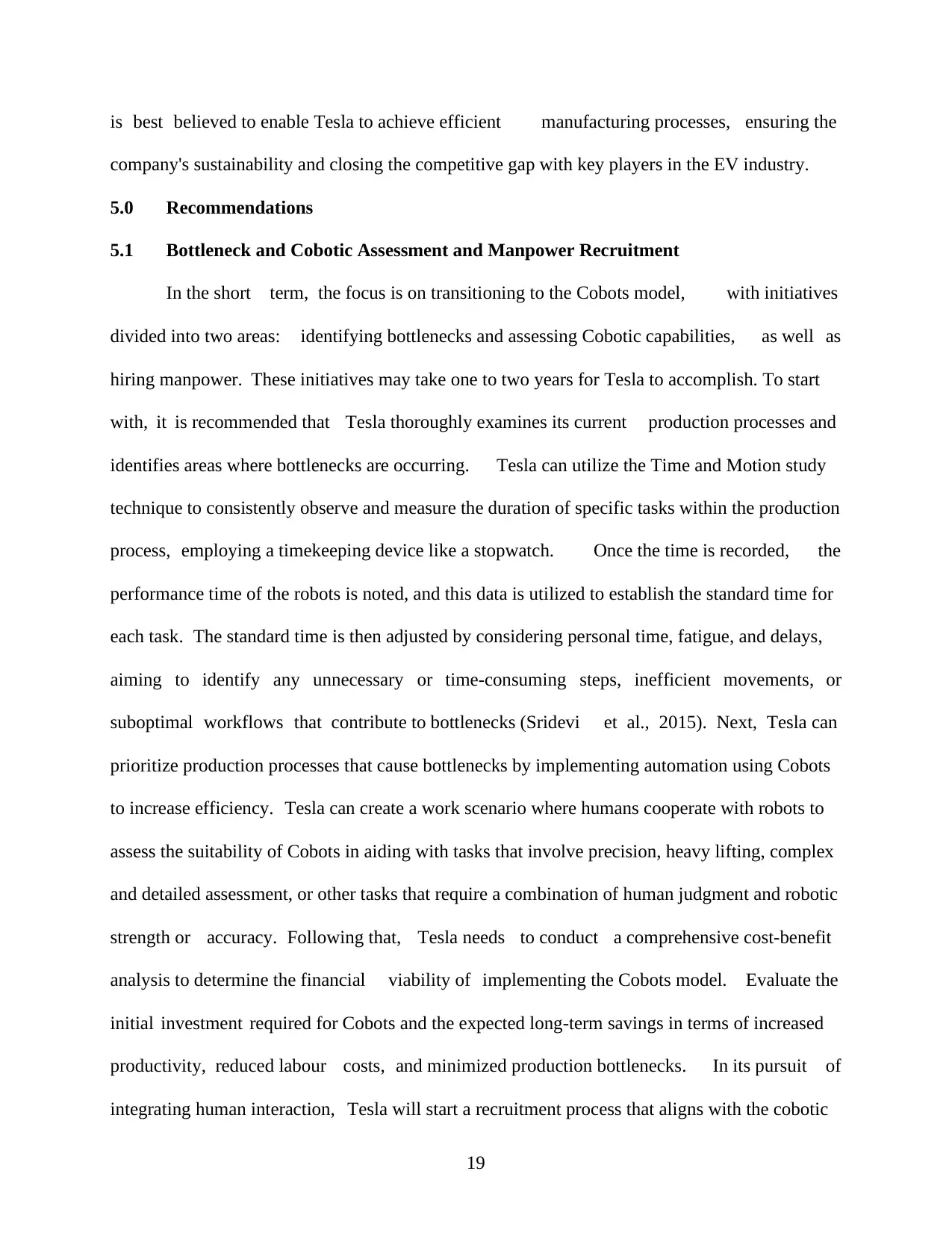
is best believed to enable Tesla to achieve efficient manufacturing processes, ensuring the
company's sustainability and closing the competitive gap with key players in the EV industry.
5.0 Recommendations
5.1 Bottleneck and Cobotic Assessment and Manpower Recruitment
In the short term, the focus is on transitioning to the Cobots model, with initiatives
divided into two areas: identifying bottlenecks and assessing Cobotic capabilities, as well as
hiring manpower. These initiatives may take one to two years for Tesla to accomplish. To start
with, it is recommended that Tesla thoroughly examines its current production processes and
identifies areas where bottlenecks are occurring. Tesla can utilize the Time and Motion study
technique to consistently observe and measure the duration of specific tasks within the production
process, employing a timekeeping device like a stopwatch. Once the time is recorded, the
performance time of the robots is noted, and this data is utilized to establish the standard time for
each task. The standard time is then adjusted by considering personal time, fatigue, and delays,
aiming to identify any unnecessary or time-consuming steps, inefficient movements, or
suboptimal workflows that contribute to bottlenecks (Sridevi et al., 2015). Next, Tesla can
prioritize production processes that cause bottlenecks by implementing automation using Cobots
to increase efficiency. Tesla can create a work scenario where humans cooperate with robots to
assess the suitability of Cobots in aiding with tasks that involve precision, heavy lifting, complex
and detailed assessment, or other tasks that require a combination of human judgment and robotic
strength or accuracy. Following that, Tesla needs to conduct a comprehensive cost-benefit
analysis to determine the financial viability of implementing the Cobots model. Evaluate the
initial investment required for Cobots and the expected long-term savings in terms of increased
productivity, reduced labour costs, and minimized production bottlenecks. In its pursuit of
integrating human interaction, Tesla will start a recruitment process that aligns with the cobotic
19
company's sustainability and closing the competitive gap with key players in the EV industry.
5.0 Recommendations
5.1 Bottleneck and Cobotic Assessment and Manpower Recruitment
In the short term, the focus is on transitioning to the Cobots model, with initiatives
divided into two areas: identifying bottlenecks and assessing Cobotic capabilities, as well as
hiring manpower. These initiatives may take one to two years for Tesla to accomplish. To start
with, it is recommended that Tesla thoroughly examines its current production processes and
identifies areas where bottlenecks are occurring. Tesla can utilize the Time and Motion study
technique to consistently observe and measure the duration of specific tasks within the production
process, employing a timekeeping device like a stopwatch. Once the time is recorded, the
performance time of the robots is noted, and this data is utilized to establish the standard time for
each task. The standard time is then adjusted by considering personal time, fatigue, and delays,
aiming to identify any unnecessary or time-consuming steps, inefficient movements, or
suboptimal workflows that contribute to bottlenecks (Sridevi et al., 2015). Next, Tesla can
prioritize production processes that cause bottlenecks by implementing automation using Cobots
to increase efficiency. Tesla can create a work scenario where humans cooperate with robots to
assess the suitability of Cobots in aiding with tasks that involve precision, heavy lifting, complex
and detailed assessment, or other tasks that require a combination of human judgment and robotic
strength or accuracy. Following that, Tesla needs to conduct a comprehensive cost-benefit
analysis to determine the financial viability of implementing the Cobots model. Evaluate the
initial investment required for Cobots and the expected long-term savings in terms of increased
productivity, reduced labour costs, and minimized production bottlenecks. In its pursuit of
integrating human interaction, Tesla will start a recruitment process that aligns with the cobotic
19

assessment. This strategic approach aims to achieve a seamless transition and maximize
operational efficiency. To accomplish this, Tesla is actively searching for highly qualified
individuals who possess the necessary expertise and qualifications to work collaboratively with
cobots, thereby ensuring a harmonious interaction between humans and robots. In order to
identify and hire the most suitable candidates, Tesla should place significant importance on
certifications from reputable institutions such as the Fanuc Certified Education Robot Training
(CERT), Certified Cobot Professional (CCP), and Yaskawa Motoman Certified Robotics
Operator (CRO). These certifications hold significant value as they have been recognized and
approved by US authorities as credible qualifications for working with cobot systems. By
prioritizing candidates with these certifications, Tesla can be confident in the candidates'
proficiency and comprehensive understanding of cobotic technologies, including operating
procedures, programming techniques, and safety protocols. Besides, the selected candidates,
equipped with the requisite qualifications, can quickly adapt to the new manufacturing
environment and contribute to the operational success of Tesla's robotic systems.
5.2 Integration of collaborative robotic systems
The following recommendation is integrating cobot systems into existing robots, a
long-term initiative that Tesla may take three to five years to accomplish. The first step towards
the integration is to build partnerships and collaboration with key players in the collaborative
robotic industry, including research institutions, robotic companies, industrial automation firms,
etc. For example, Tesla can collaborate with KUKA Robotics for their expertise in advanced
cobot software. KUKA has experience in cobot and production systems within the automotive
industry (KUKA, n.d.). Thus, it can offer personalized solutions designed specifically for Tesla's
production requirements. In addition, research and development could focus on enhancing the
safety of cobot systems together with Rethink Robotics by creating cobots with advanced safety
20
operational efficiency. To accomplish this, Tesla is actively searching for highly qualified
individuals who possess the necessary expertise and qualifications to work collaboratively with
cobots, thereby ensuring a harmonious interaction between humans and robots. In order to
identify and hire the most suitable candidates, Tesla should place significant importance on
certifications from reputable institutions such as the Fanuc Certified Education Robot Training
(CERT), Certified Cobot Professional (CCP), and Yaskawa Motoman Certified Robotics
Operator (CRO). These certifications hold significant value as they have been recognized and
approved by US authorities as credible qualifications for working with cobot systems. By
prioritizing candidates with these certifications, Tesla can be confident in the candidates'
proficiency and comprehensive understanding of cobotic technologies, including operating
procedures, programming techniques, and safety protocols. Besides, the selected candidates,
equipped with the requisite qualifications, can quickly adapt to the new manufacturing
environment and contribute to the operational success of Tesla's robotic systems.
5.2 Integration of collaborative robotic systems
The following recommendation is integrating cobot systems into existing robots, a
long-term initiative that Tesla may take three to five years to accomplish. The first step towards
the integration is to build partnerships and collaboration with key players in the collaborative
robotic industry, including research institutions, robotic companies, industrial automation firms,
etc. For example, Tesla can collaborate with KUKA Robotics for their expertise in advanced
cobot software. KUKA has experience in cobot and production systems within the automotive
industry (KUKA, n.d.). Thus, it can offer personalized solutions designed specifically for Tesla's
production requirements. In addition, research and development could focus on enhancing the
safety of cobot systems together with Rethink Robotics by creating cobots with advanced safety
20
Secure Best Marks with AI Grader
Need help grading? Try our AI Grader for instant feedback on your assignments.
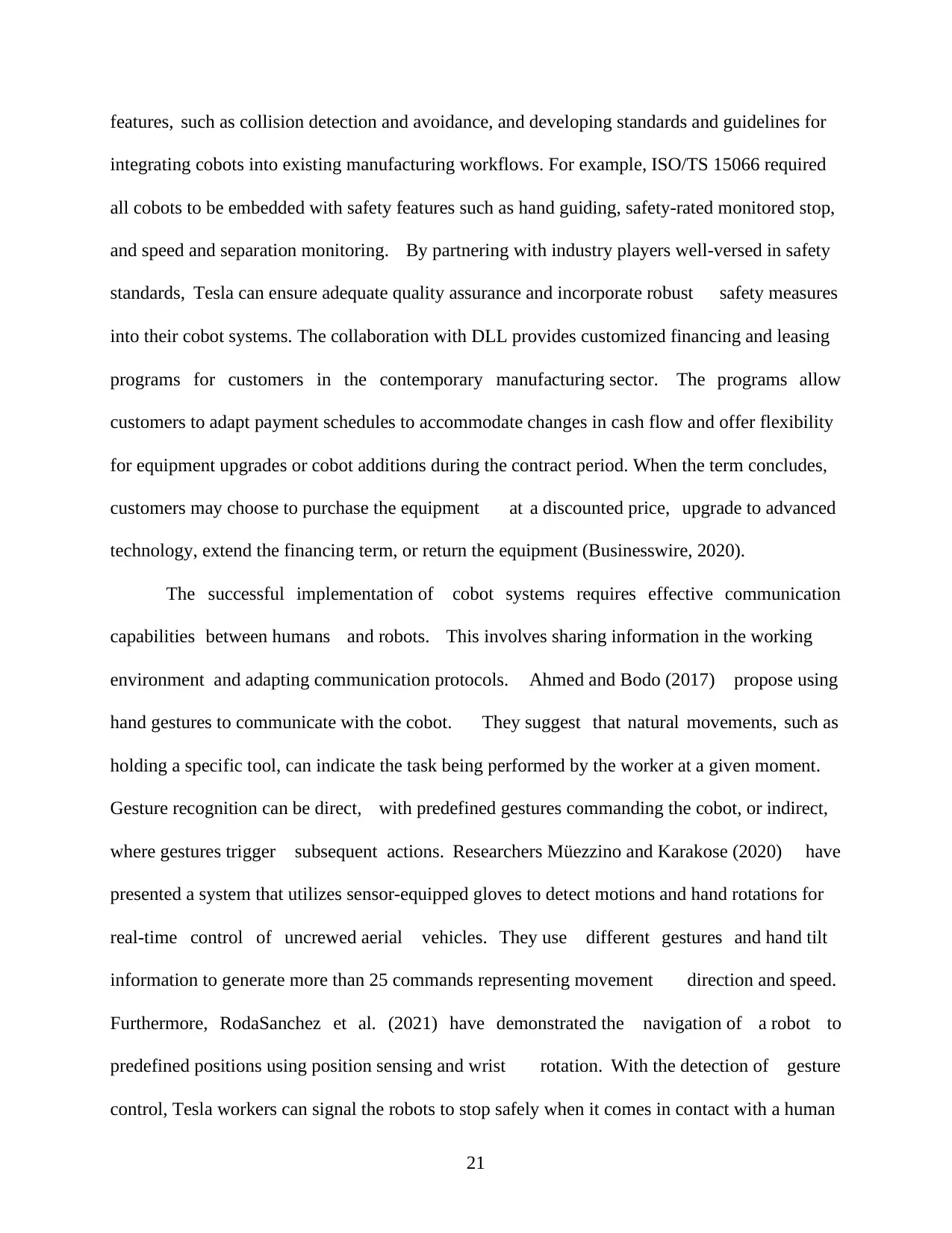
features, such as collision detection and avoidance, and developing standards and guidelines for
integrating cobots into existing manufacturing workflows. For example, ISO/TS 15066 required
all cobots to be embedded with safety features such as hand guiding, safety-rated monitored stop,
and speed and separation monitoring. By partnering with industry players well-versed in safety
standards, Tesla can ensure adequate quality assurance and incorporate robust safety measures
into their cobot systems. The collaboration with DLL provides customized financing and leasing
programs for customers in the contemporary manufacturing sector. The programs allow
customers to adapt payment schedules to accommodate changes in cash flow and offer flexibility
for equipment upgrades or cobot additions during the contract period. When the term concludes,
customers may choose to purchase the equipment at a discounted price, upgrade to advanced
technology, extend the financing term, or return the equipment (Businesswire, 2020).
The successful implementation of cobot systems requires effective communication
capabilities between humans and robots. This involves sharing information in the working
environment and adapting communication protocols. Ahmed and Bodo (2017) propose using
hand gestures to communicate with the cobot. They suggest that natural movements, such as
holding a specific tool, can indicate the task being performed by the worker at a given moment.
Gesture recognition can be direct, with predefined gestures commanding the cobot, or indirect,
where gestures trigger subsequent actions. Researchers Müezzino and Karakose (2020) have
presented a system that utilizes sensor-equipped gloves to detect motions and hand rotations for
real-time control of uncrewed aerial vehicles. They use different gestures and hand tilt
information to generate more than 25 commands representing movement direction and speed.
Furthermore, RodaSanchez et al. (2021) have demonstrated the navigation of a robot to
predefined positions using position sensing and wrist rotation. With the detection of gesture
control, Tesla workers can signal the robots to stop safely when it comes in contact with a human
21
integrating cobots into existing manufacturing workflows. For example, ISO/TS 15066 required
all cobots to be embedded with safety features such as hand guiding, safety-rated monitored stop,
and speed and separation monitoring. By partnering with industry players well-versed in safety
standards, Tesla can ensure adequate quality assurance and incorporate robust safety measures
into their cobot systems. The collaboration with DLL provides customized financing and leasing
programs for customers in the contemporary manufacturing sector. The programs allow
customers to adapt payment schedules to accommodate changes in cash flow and offer flexibility
for equipment upgrades or cobot additions during the contract period. When the term concludes,
customers may choose to purchase the equipment at a discounted price, upgrade to advanced
technology, extend the financing term, or return the equipment (Businesswire, 2020).
The successful implementation of cobot systems requires effective communication
capabilities between humans and robots. This involves sharing information in the working
environment and adapting communication protocols. Ahmed and Bodo (2017) propose using
hand gestures to communicate with the cobot. They suggest that natural movements, such as
holding a specific tool, can indicate the task being performed by the worker at a given moment.
Gesture recognition can be direct, with predefined gestures commanding the cobot, or indirect,
where gestures trigger subsequent actions. Researchers Müezzino and Karakose (2020) have
presented a system that utilizes sensor-equipped gloves to detect motions and hand rotations for
real-time control of uncrewed aerial vehicles. They use different gestures and hand tilt
information to generate more than 25 commands representing movement direction and speed.
Furthermore, RodaSanchez et al. (2021) have demonstrated the navigation of a robot to
predefined positions using position sensing and wrist rotation. With the detection of gesture
control, Tesla workers can signal the robots to stop safely when it comes in contact with a human
21

operator. Hence, Tesla operators should be provided comprehensive training on gesture control
practices in cobot systems to ensure best practices for safe and effective collaboration. It is worth
noting that through gesture control, Tesla can extend beyond human-robot collaboration and
enable precise control and coordination in manufacturing operations.
Next, Tesla could allocate resources to programming the functionalities of a cobot system
into their current production line robots. Tesla could incorporate human-centred augmented
intelligence (AI) and complementary sensors. Zhou et al. (2021) highlighted that AI involves
human-machine collaboration, where machines with high levels of information processing
perform tasks such as computation, recording, and routine work, to assist humans in making more
holistic, intuitive approaches to semi-structured tasks. At Tesla's gigafactory, using AI technology
in cobots may enhance maintenance tasks for technicians. They can access a heads-up display in
the robots that provides real-time digital overlays of manuals and blueprints (Vysocky et al.,
2023), allowing them to ensure precise alignment and accuracy during inspections. The cobots
also offer machine-specific information to troubleshoot unfamiliar parts and perform
maintenance efficiently. Ultimately, this leads to increased efficiency, accuracy, and the
production of high-quality Tesla vehicles. In addition to HAI, additional sensors can be added to
enhance perception and situational awareness. For instance, motion-capturing sensors in the
existing robots and front cameras may yield highly precise data for gesture recognition tasks
(Vysocky et al., 2023). These advanced systems allow operators to perform high-precision
inspections and ensure consistent quality control throughout manufacturing. Tesla could also
implement collision avoidance algorithms that actively monitor the robot's workspace and adjust
its movements to avoid obstacles or humans. These sensors should be designed to meet safety
standards such as ISO 10218 and ISO/TS 15066.
22
practices in cobot systems to ensure best practices for safe and effective collaboration. It is worth
noting that through gesture control, Tesla can extend beyond human-robot collaboration and
enable precise control and coordination in manufacturing operations.
Next, Tesla could allocate resources to programming the functionalities of a cobot system
into their current production line robots. Tesla could incorporate human-centred augmented
intelligence (AI) and complementary sensors. Zhou et al. (2021) highlighted that AI involves
human-machine collaboration, where machines with high levels of information processing
perform tasks such as computation, recording, and routine work, to assist humans in making more
holistic, intuitive approaches to semi-structured tasks. At Tesla's gigafactory, using AI technology
in cobots may enhance maintenance tasks for technicians. They can access a heads-up display in
the robots that provides real-time digital overlays of manuals and blueprints (Vysocky et al.,
2023), allowing them to ensure precise alignment and accuracy during inspections. The cobots
also offer machine-specific information to troubleshoot unfamiliar parts and perform
maintenance efficiently. Ultimately, this leads to increased efficiency, accuracy, and the
production of high-quality Tesla vehicles. In addition to HAI, additional sensors can be added to
enhance perception and situational awareness. For instance, motion-capturing sensors in the
existing robots and front cameras may yield highly precise data for gesture recognition tasks
(Vysocky et al., 2023). These advanced systems allow operators to perform high-precision
inspections and ensure consistent quality control throughout manufacturing. Tesla could also
implement collision avoidance algorithms that actively monitor the robot's workspace and adjust
its movements to avoid obstacles or humans. These sensors should be designed to meet safety
standards such as ISO 10218 and ISO/TS 15066.
22
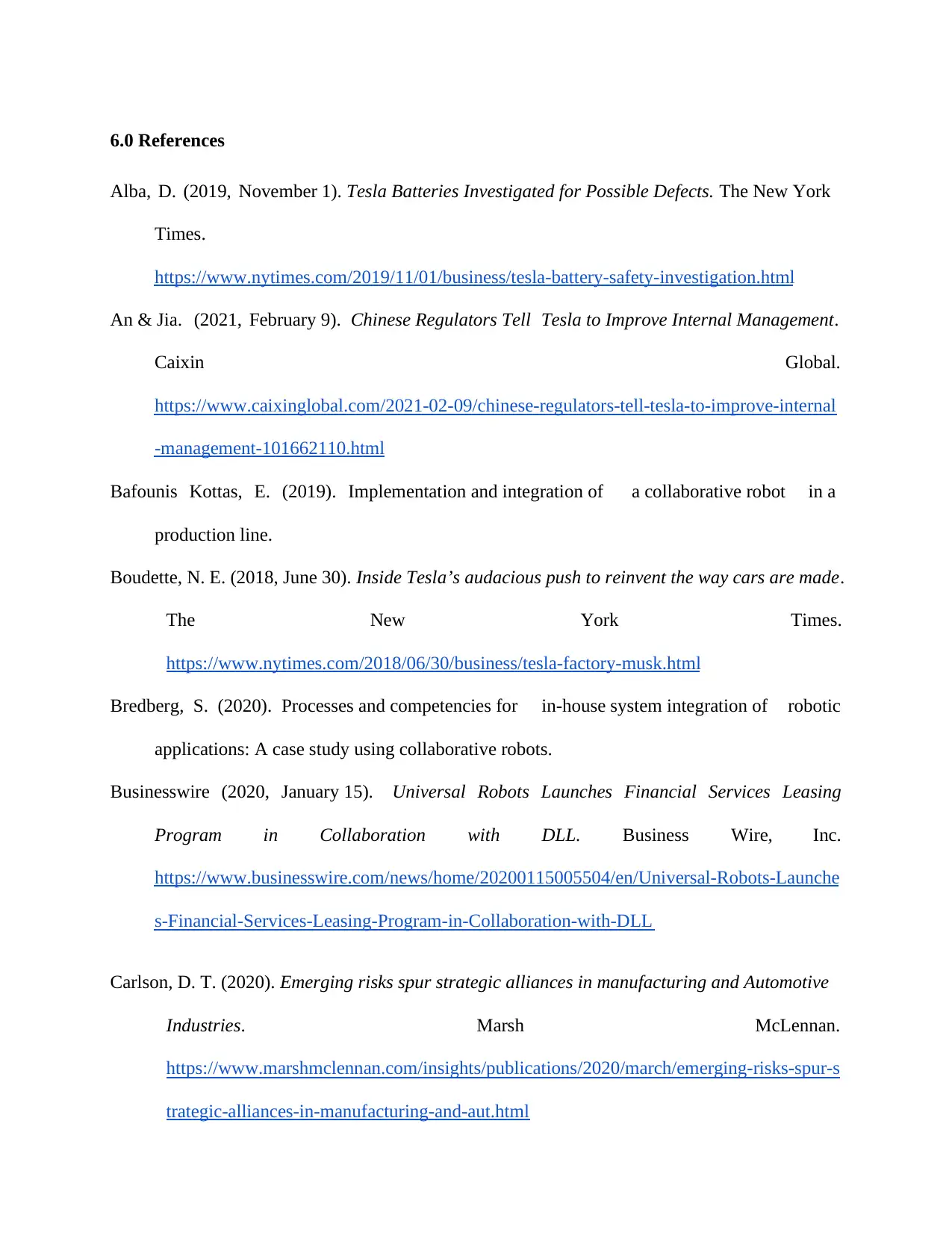
6.0 References
Alba, D. (2019, November 1). Tesla Batteries Investigated for Possible Defects. The New York
Times.
https://www.nytimes.com/2019/11/01/business/tesla-battery-safety-investigation.html
An & Jia. (2021, February 9). Chinese Regulators Tell Tesla to Improve Internal Management.
Caixin Global.
https://www.caixinglobal.com/2021-02-09/chinese-regulators-tell-tesla-to-improve-internal
-management-101662110.html
Bafounis Kottas, E. (2019). Implementation and integration of a collaborative robot in a
production line.
Boudette, N. E. (2018, June 30). Inside Tesla’s audacious push to reinvent the way cars are made.
The New York Times.
https://www.nytimes.com/2018/06/30/business/tesla-factory-musk.html
Bredberg, S. (2020). Processes and competencies for in-house system integration of robotic
applications: A case study using collaborative robots.
Businesswire (2020, January 15). Universal Robots Launches Financial Services Leasing
Program in Collaboration with DLL. Business Wire, Inc.
https://www.businesswire.com/news/home/20200115005504/en/Universal-Robots-Launche
s-Financial-Services-Leasing-Program-in-Collaboration-with-DLL
Carlson, D. T. (2020). Emerging risks spur strategic alliances in manufacturing and Automotive
Industries. Marsh McLennan.
https://www.marshmclennan.com/insights/publications/2020/march/emerging-risks-spur-s
trategic-alliances-in-manufacturing-and-aut.html
Alba, D. (2019, November 1). Tesla Batteries Investigated for Possible Defects. The New York
Times.
https://www.nytimes.com/2019/11/01/business/tesla-battery-safety-investigation.html
An & Jia. (2021, February 9). Chinese Regulators Tell Tesla to Improve Internal Management.
Caixin Global.
https://www.caixinglobal.com/2021-02-09/chinese-regulators-tell-tesla-to-improve-internal
-management-101662110.html
Bafounis Kottas, E. (2019). Implementation and integration of a collaborative robot in a
production line.
Boudette, N. E. (2018, June 30). Inside Tesla’s audacious push to reinvent the way cars are made.
The New York Times.
https://www.nytimes.com/2018/06/30/business/tesla-factory-musk.html
Bredberg, S. (2020). Processes and competencies for in-house system integration of robotic
applications: A case study using collaborative robots.
Businesswire (2020, January 15). Universal Robots Launches Financial Services Leasing
Program in Collaboration with DLL. Business Wire, Inc.
https://www.businesswire.com/news/home/20200115005504/en/Universal-Robots-Launche
s-Financial-Services-Leasing-Program-in-Collaboration-with-DLL
Carlson, D. T. (2020). Emerging risks spur strategic alliances in manufacturing and Automotive
Industries. Marsh McLennan.
https://www.marshmclennan.com/insights/publications/2020/march/emerging-risks-spur-s
trategic-alliances-in-manufacturing-and-aut.html
Paraphrase This Document
Need a fresh take? Get an instant paraphrase of this document with our AI Paraphraser

Čirjevskis, A. (2021). Exploring critical success factors of competence-based synergy in strategic
alliances: The Renault–Nissan–mitsubishi strategic alliance. Journal of Risk and
Financial Management, 14(8), 385. https://doi.org/10.3390/jrfm14080385
Faccio, M., Granata, I., Menini, A., Milanese, M., Rossato, C., Bottin, M., ... & Rosati, G. (2022,
November 22). Human factors in cobot era: a review of modern production systems
features. Journal of Intelligent Manufacturing, 34(1), 85-106.
https://link.springer.com/article/10.1007/s10845-022-01953-w
Faccio, M., Granata, I., Menini, A., Milanese, M., Rossato, C., Bottin, M., ... & Rosati, G. (2023).
Human factors in cobot era: a review of modern production systems features. Journal of
Intelligent Manufacturing, 34(1), 85-106
Fast-Berglund, Å., & Romero, D. (2019). Strategies for implementing collaborative robot
applications for the operator 4.0. In Advances in Production Management Systems.
Production Management for the Factory of the Future: IFIP WG 5.7 International
Conference, APMS 2019, Austin, TX, USA, September 1–5, 2019, Proceedings, Part I (pp.
682-689). Springer International Publishing.
Gellendin, A. L. (2022). Increasing production efficiency in the automotive industry.
GEFASOFT.
https://www.gefasoft.de/en/increasing-production-efficiency-in-the-automotive-industry/
Greenfield. (2018) Universal Robots unveils new 20kg payload cobot.
https://www.automationworld.com/factory/robotics/article/22288597/universal-robots-unve
ils-new-20kg-payload-cobot
Guardian News and Media. (2015, December 10). VW admits the emissions scandal was caused
by “whole chain” of failures. The Guardian.
https://www.theguardian.com/business/2015/dec/10/volkswagen-emissions-scandal-system
alliances: The Renault–Nissan–mitsubishi strategic alliance. Journal of Risk and
Financial Management, 14(8), 385. https://doi.org/10.3390/jrfm14080385
Faccio, M., Granata, I., Menini, A., Milanese, M., Rossato, C., Bottin, M., ... & Rosati, G. (2022,
November 22). Human factors in cobot era: a review of modern production systems
features. Journal of Intelligent Manufacturing, 34(1), 85-106.
https://link.springer.com/article/10.1007/s10845-022-01953-w
Faccio, M., Granata, I., Menini, A., Milanese, M., Rossato, C., Bottin, M., ... & Rosati, G. (2023).
Human factors in cobot era: a review of modern production systems features. Journal of
Intelligent Manufacturing, 34(1), 85-106
Fast-Berglund, Å., & Romero, D. (2019). Strategies for implementing collaborative robot
applications for the operator 4.0. In Advances in Production Management Systems.
Production Management for the Factory of the Future: IFIP WG 5.7 International
Conference, APMS 2019, Austin, TX, USA, September 1–5, 2019, Proceedings, Part I (pp.
682-689). Springer International Publishing.
Gellendin, A. L. (2022). Increasing production efficiency in the automotive industry.
GEFASOFT.
https://www.gefasoft.de/en/increasing-production-efficiency-in-the-automotive-industry/
Greenfield. (2018) Universal Robots unveils new 20kg payload cobot.
https://www.automationworld.com/factory/robotics/article/22288597/universal-robots-unve
ils-new-20kg-payload-cobot
Guardian News and Media. (2015, December 10). VW admits the emissions scandal was caused
by “whole chain” of failures. The Guardian.
https://www.theguardian.com/business/2015/dec/10/volkswagen-emissions-scandal-system
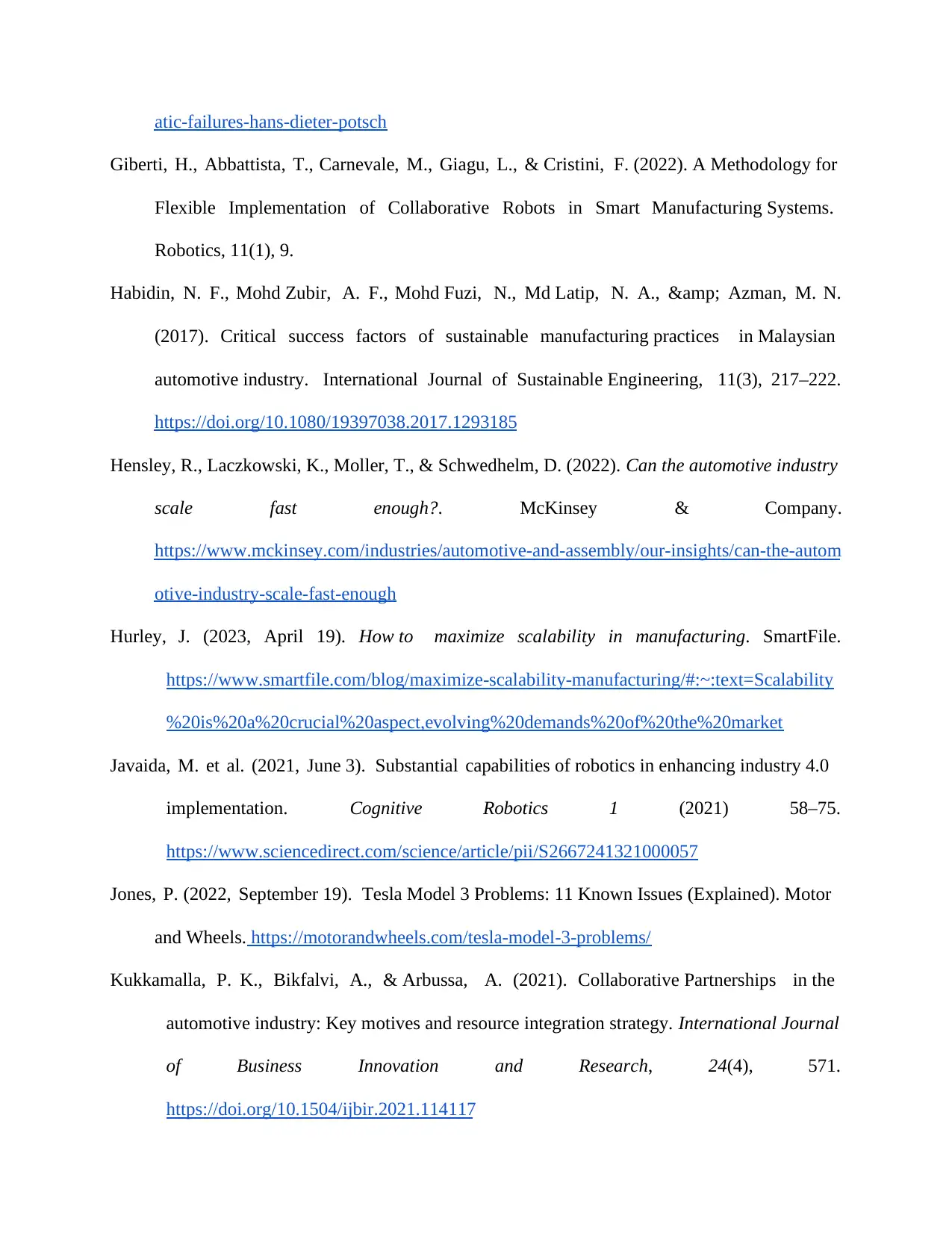
atic-failures-hans-dieter-potsch
Giberti, H., Abbattista, T., Carnevale, M., Giagu, L., & Cristini, F. (2022). A Methodology for
Flexible Implementation of Collaborative Robots in Smart Manufacturing Systems.
Robotics, 11(1), 9.
Habidin, N. F., Mohd Zubir, A. F., Mohd Fuzi, N., Md Latip, N. A., & Azman, M. N.
(2017). Critical success factors of sustainable manufacturing practices in Malaysian
automotive industry. International Journal of Sustainable Engineering, 11(3), 217–222.
https://doi.org/10.1080/19397038.2017.1293185
Hensley, R., Laczkowski, K., Moller, T., & Schwedhelm, D. (2022). Can the automotive industry
scale fast enough?. McKinsey & Company.
https://www.mckinsey.com/industries/automotive-and-assembly/our-insights/can-the-autom
otive-industry-scale-fast-enough
Hurley, J. (2023, April 19). How to maximize scalability in manufacturing. SmartFile.
https://www.smartfile.com/blog/maximize-scalability-manufacturing/#:~:text=Scalability
%20is%20a%20crucial%20aspect,evolving%20demands%20of%20the%20market
Javaida, M. et al. (2021, June 3). Substantial capabilities of robotics in enhancing industry 4.0
implementation. Cognitive Robotics 1 (2021) 58–75.
https://www.sciencedirect.com/science/article/pii/S2667241321000057
Jones, P. (2022, September 19). Tesla Model 3 Problems: 11 Known Issues (Explained). Motor
and Wheels. https://motorandwheels.com/tesla-model-3-problems/
Kukkamalla, P. K., Bikfalvi, A., & Arbussa, A. (2021). Collaborative Partnerships in the
automotive industry: Key motives and resource integration strategy. International Journal
of Business Innovation and Research, 24(4), 571.
https://doi.org/10.1504/ijbir.2021.114117
Giberti, H., Abbattista, T., Carnevale, M., Giagu, L., & Cristini, F. (2022). A Methodology for
Flexible Implementation of Collaborative Robots in Smart Manufacturing Systems.
Robotics, 11(1), 9.
Habidin, N. F., Mohd Zubir, A. F., Mohd Fuzi, N., Md Latip, N. A., & Azman, M. N.
(2017). Critical success factors of sustainable manufacturing practices in Malaysian
automotive industry. International Journal of Sustainable Engineering, 11(3), 217–222.
https://doi.org/10.1080/19397038.2017.1293185
Hensley, R., Laczkowski, K., Moller, T., & Schwedhelm, D. (2022). Can the automotive industry
scale fast enough?. McKinsey & Company.
https://www.mckinsey.com/industries/automotive-and-assembly/our-insights/can-the-autom
otive-industry-scale-fast-enough
Hurley, J. (2023, April 19). How to maximize scalability in manufacturing. SmartFile.
https://www.smartfile.com/blog/maximize-scalability-manufacturing/#:~:text=Scalability
%20is%20a%20crucial%20aspect,evolving%20demands%20of%20the%20market
Javaida, M. et al. (2021, June 3). Substantial capabilities of robotics in enhancing industry 4.0
implementation. Cognitive Robotics 1 (2021) 58–75.
https://www.sciencedirect.com/science/article/pii/S2667241321000057
Jones, P. (2022, September 19). Tesla Model 3 Problems: 11 Known Issues (Explained). Motor
and Wheels. https://motorandwheels.com/tesla-model-3-problems/
Kukkamalla, P. K., Bikfalvi, A., & Arbussa, A. (2021). Collaborative Partnerships in the
automotive industry: Key motives and resource integration strategy. International Journal
of Business Innovation and Research, 24(4), 571.
https://doi.org/10.1504/ijbir.2021.114117
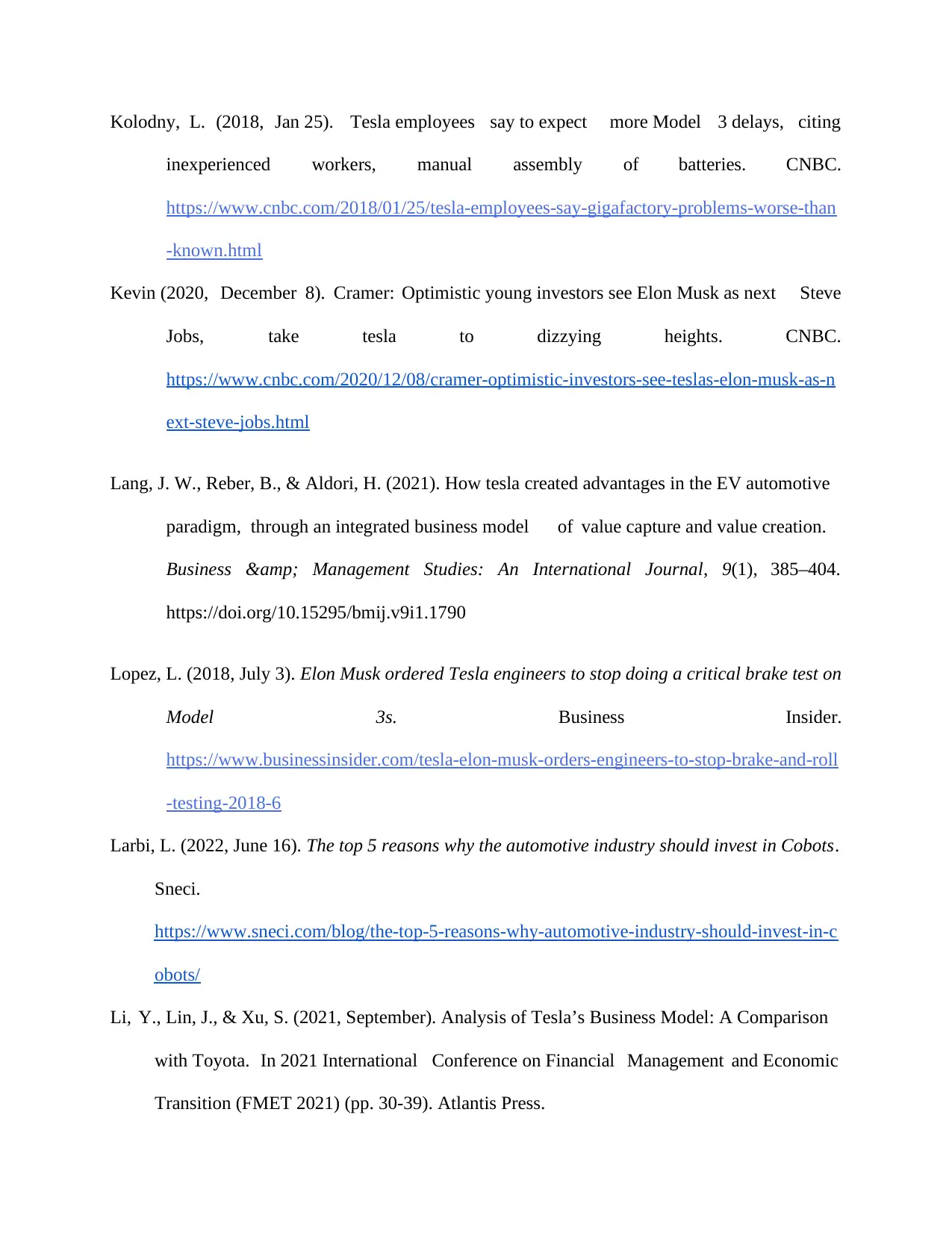
Kolodny, L. (2018, Jan 25). Tesla employees say to expect more Model 3 delays, citing
inexperienced workers, manual assembly of batteries. CNBC.
https://www.cnbc.com/2018/01/25/tesla-employees-say-gigafactory-problems-worse-than
-known.html
Kevin (2020, December 8). Cramer: Optimistic young investors see Elon Musk as next Steve
Jobs, take tesla to dizzying heights. CNBC.
https://www.cnbc.com/2020/12/08/cramer-optimistic-investors-see-teslas-elon-musk-as-n
ext-steve-jobs.html
Lang, J. W., Reber, B., & Aldori, H. (2021). How tesla created advantages in the EV automotive
paradigm, through an integrated business model of value capture and value creation.
Business & Management Studies: An International Journal, 9(1), 385–404.
https://doi.org/10.15295/bmij.v9i1.1790
Lopez, L. (2018, July 3). Elon Musk ordered Tesla engineers to stop doing a critical brake test on
Model 3s. Business Insider.
https://www.businessinsider.com/tesla-elon-musk-orders-engineers-to-stop-brake-and-roll
-testing-2018-6
Larbi, L. (2022, June 16). The top 5 reasons why the automotive industry should invest in Cobots.
Sneci.
https://www.sneci.com/blog/the-top-5-reasons-why-automotive-industry-should-invest-in-c
obots/
Li, Y., Lin, J., & Xu, S. (2021, September). Analysis of Tesla’s Business Model: A Comparison
with Toyota. In 2021 International Conference on Financial Management and Economic
Transition (FMET 2021) (pp. 30-39). Atlantis Press.
inexperienced workers, manual assembly of batteries. CNBC.
https://www.cnbc.com/2018/01/25/tesla-employees-say-gigafactory-problems-worse-than
-known.html
Kevin (2020, December 8). Cramer: Optimistic young investors see Elon Musk as next Steve
Jobs, take tesla to dizzying heights. CNBC.
https://www.cnbc.com/2020/12/08/cramer-optimistic-investors-see-teslas-elon-musk-as-n
ext-steve-jobs.html
Lang, J. W., Reber, B., & Aldori, H. (2021). How tesla created advantages in the EV automotive
paradigm, through an integrated business model of value capture and value creation.
Business & Management Studies: An International Journal, 9(1), 385–404.
https://doi.org/10.15295/bmij.v9i1.1790
Lopez, L. (2018, July 3). Elon Musk ordered Tesla engineers to stop doing a critical brake test on
Model 3s. Business Insider.
https://www.businessinsider.com/tesla-elon-musk-orders-engineers-to-stop-brake-and-roll
-testing-2018-6
Larbi, L. (2022, June 16). The top 5 reasons why the automotive industry should invest in Cobots.
Sneci.
https://www.sneci.com/blog/the-top-5-reasons-why-automotive-industry-should-invest-in-c
obots/
Li, Y., Lin, J., & Xu, S. (2021, September). Analysis of Tesla’s Business Model: A Comparison
with Toyota. In 2021 International Conference on Financial Management and Economic
Transition (FMET 2021) (pp. 30-39). Atlantis Press.
Secure Best Marks with AI Grader
Need help grading? Try our AI Grader for instant feedback on your assignments.
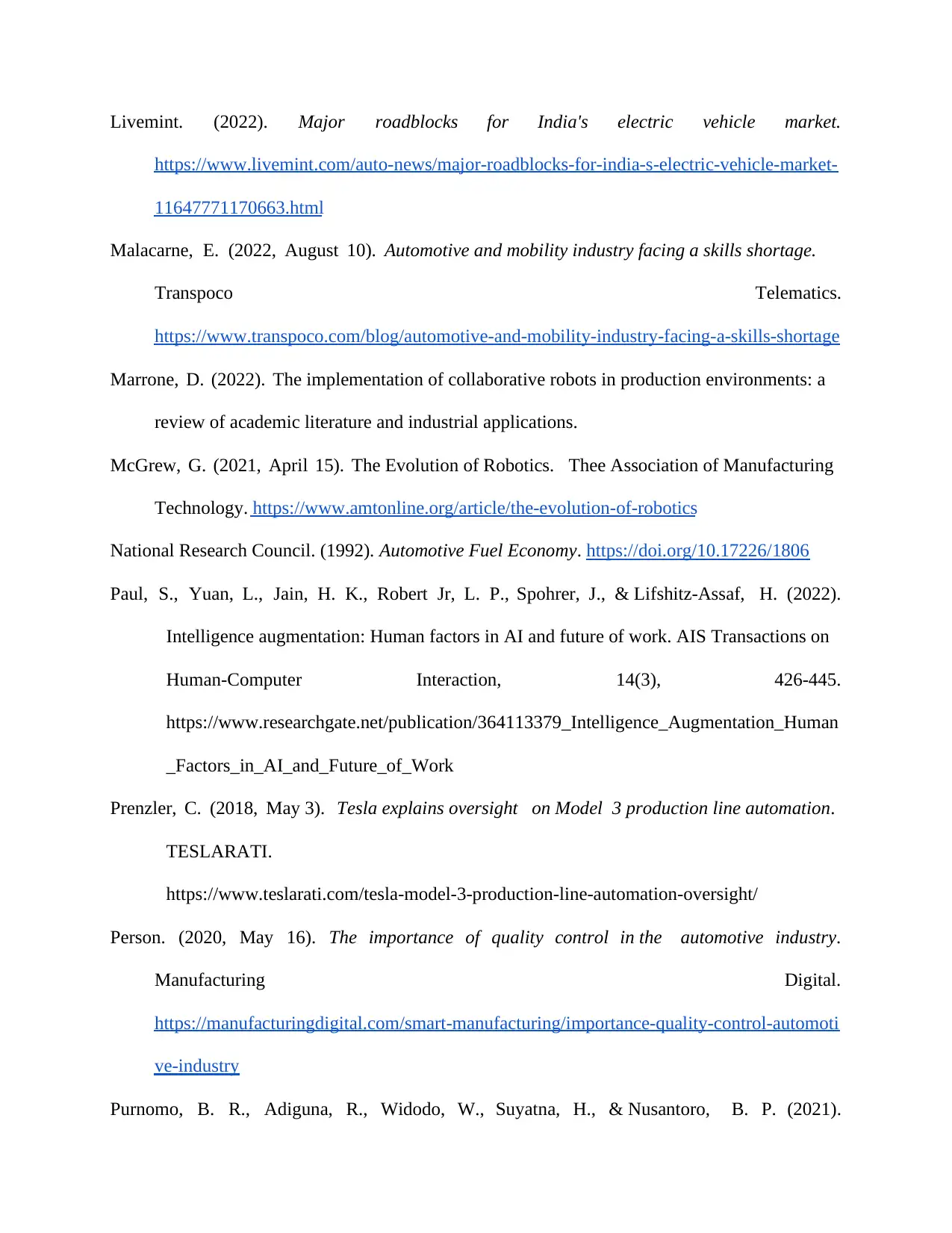
Livemint. (2022). Major roadblocks for India's electric vehicle market.
https://www.livemint.com/auto-news/major-roadblocks-for-india-s-electric-vehicle-market-
11647771170663.html
Malacarne, E. (2022, August 10). Automotive and mobility industry facing a skills shortage.
Transpoco Telematics.
https://www.transpoco.com/blog/automotive-and-mobility-industry-facing-a-skills-shortage
Marrone, D. (2022). The implementation of collaborative robots in production environments: a
review of academic literature and industrial applications.
McGrew, G. (2021, April 15). The Evolution of Robotics. Thee Association of Manufacturing
Technology. https://www.amtonline.org/article/the-evolution-of-robotics
National Research Council. (1992). Automotive Fuel Economy. https://doi.org/10.17226/1806
Paul, S., Yuan, L., Jain, H. K., Robert Jr, L. P., Spohrer, J., & Lifshitz-Assaf, H. (2022).
Intelligence augmentation: Human factors in AI and future of work. AIS Transactions on
Human-Computer Interaction, 14(3), 426-445.
https://www.researchgate.net/publication/364113379_Intelligence_Augmentation_Human
_Factors_in_AI_and_Future_of_Work
Prenzler, C. (2018, May 3). Tesla explains oversight on Model 3 production line automation.
TESLARATI.
https://www.teslarati.com/tesla-model-3-production-line-automation-oversight/
Person. (2020, May 16). The importance of quality control in the automotive industry.
Manufacturing Digital.
https://manufacturingdigital.com/smart-manufacturing/importance-quality-control-automoti
ve-industry
Purnomo, B. R., Adiguna, R., Widodo, W., Suyatna, H., & Nusantoro, B. P. (2021).
https://www.livemint.com/auto-news/major-roadblocks-for-india-s-electric-vehicle-market-
11647771170663.html
Malacarne, E. (2022, August 10). Automotive and mobility industry facing a skills shortage.
Transpoco Telematics.
https://www.transpoco.com/blog/automotive-and-mobility-industry-facing-a-skills-shortage
Marrone, D. (2022). The implementation of collaborative robots in production environments: a
review of academic literature and industrial applications.
McGrew, G. (2021, April 15). The Evolution of Robotics. Thee Association of Manufacturing
Technology. https://www.amtonline.org/article/the-evolution-of-robotics
National Research Council. (1992). Automotive Fuel Economy. https://doi.org/10.17226/1806
Paul, S., Yuan, L., Jain, H. K., Robert Jr, L. P., Spohrer, J., & Lifshitz-Assaf, H. (2022).
Intelligence augmentation: Human factors in AI and future of work. AIS Transactions on
Human-Computer Interaction, 14(3), 426-445.
https://www.researchgate.net/publication/364113379_Intelligence_Augmentation_Human
_Factors_in_AI_and_Future_of_Work
Prenzler, C. (2018, May 3). Tesla explains oversight on Model 3 production line automation.
TESLARATI.
https://www.teslarati.com/tesla-model-3-production-line-automation-oversight/
Person. (2020, May 16). The importance of quality control in the automotive industry.
Manufacturing Digital.
https://manufacturingdigital.com/smart-manufacturing/importance-quality-control-automoti
ve-industry
Purnomo, B. R., Adiguna, R., Widodo, W., Suyatna, H., & Nusantoro, B. P. (2021).

Entrepreneurial resilience during the Covid-19 pandemic: navigating survival, continuity
and growth. Journal of Entrepreneurship in Emerging Economies.
Reuters. (2021, February 5). Tesla's Musk says U.S. factory closed for two days due to parts
shortages. Reuters. https://www.reuters.com/article/us-tesla-production-idCAKBN2AP12J
Robinson, J., Brase, G., Griswold, W., Jackson, C., & Erickson, L. (2014). Business models for
solar powered charging stations to develop infrastructure for electric vehicles.
Sustainability, 6(10), 7358-7387.
Sadik, A. R., & Urban, B. (2017). An ontology-based approach to enable knowledge
representation and reasoning in worker–cobot agile manufacturing. Future Internet, 9(4),
90. https://www.mdpi.com/1999-5903/9/4/90
Sridevi, S., Sengottuvel, P., Jayaraj, D., & Ganesan, M. (2015). Bottleneck Analysis of an
automobile industry component. Indian Journal of Science and Technology, 8(31).
https://doi.org/10.17485/ijst/2015/v8i1/84222
Teece, D. J. (2018). Tesla and the reshaping of the auto industry. Management and Organization
Review, 14(3), 501-512.
Tesla Q1 deliveries sequentially down; warns of Q1 profit. Nasdaq. (2019, April 3).
https://www.nasdaq.com/articles/tesla-q1-deliveries-sequentially-down-warns-q1-profit-2
019-04-03?amp
Universal Robot. (2021). How Cobots address key challenges in automotive production.
Collaborative robotic automation.
https://www.universal-robots.com/blog/how-cobots-address-key-challenges-in-automotiv
e-production/
Vysocký, A., Poštulka, T., Chlebek, J., Kot, T., Maslowski, J., & Grushko, S. (2023). Hand
Gesture Interface for Robot Path Definition in Collaborative Applications:
and growth. Journal of Entrepreneurship in Emerging Economies.
Reuters. (2021, February 5). Tesla's Musk says U.S. factory closed for two days due to parts
shortages. Reuters. https://www.reuters.com/article/us-tesla-production-idCAKBN2AP12J
Robinson, J., Brase, G., Griswold, W., Jackson, C., & Erickson, L. (2014). Business models for
solar powered charging stations to develop infrastructure for electric vehicles.
Sustainability, 6(10), 7358-7387.
Sadik, A. R., & Urban, B. (2017). An ontology-based approach to enable knowledge
representation and reasoning in worker–cobot agile manufacturing. Future Internet, 9(4),
90. https://www.mdpi.com/1999-5903/9/4/90
Sridevi, S., Sengottuvel, P., Jayaraj, D., & Ganesan, M. (2015). Bottleneck Analysis of an
automobile industry component. Indian Journal of Science and Technology, 8(31).
https://doi.org/10.17485/ijst/2015/v8i1/84222
Teece, D. J. (2018). Tesla and the reshaping of the auto industry. Management and Organization
Review, 14(3), 501-512.
Tesla Q1 deliveries sequentially down; warns of Q1 profit. Nasdaq. (2019, April 3).
https://www.nasdaq.com/articles/tesla-q1-deliveries-sequentially-down-warns-q1-profit-2
019-04-03?amp
Universal Robot. (2021). How Cobots address key challenges in automotive production.
Collaborative robotic automation.
https://www.universal-robots.com/blog/how-cobots-address-key-challenges-in-automotiv
e-production/
Vysocký, A., Poštulka, T., Chlebek, J., Kot, T., Maslowski, J., & Grushko, S. (2023). Hand
Gesture Interface for Robot Path Definition in Collaborative Applications:
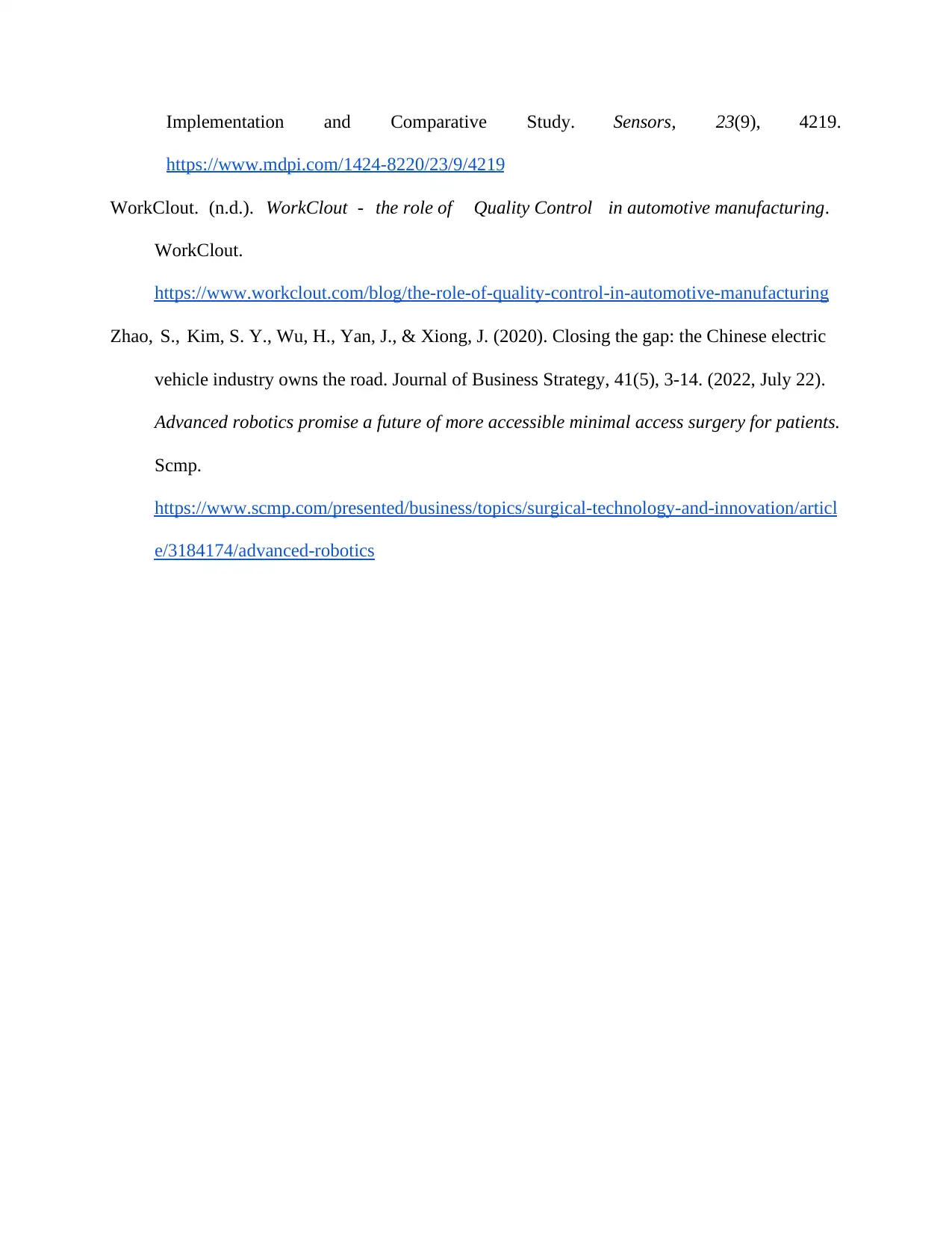
Implementation and Comparative Study. Sensors, 23(9), 4219.
https://www.mdpi.com/1424-8220/23/9/4219
WorkClout. (n.d.). WorkClout - the role of Quality Control in automotive manufacturing.
WorkClout.
https://www.workclout.com/blog/the-role-of-quality-control-in-automotive-manufacturing
Zhao, S., Kim, S. Y., Wu, H., Yan, J., & Xiong, J. (2020). Closing the gap: the Chinese electric
vehicle industry owns the road. Journal of Business Strategy, 41(5), 3-14. (2022, July 22).
Advanced robotics promise a future of more accessible minimal access surgery for patients.
Scmp.
https://www.scmp.com/presented/business/topics/surgical-technology-and-innovation/articl
e/3184174/advanced-robotics
https://www.mdpi.com/1424-8220/23/9/4219
WorkClout. (n.d.). WorkClout - the role of Quality Control in automotive manufacturing.
WorkClout.
https://www.workclout.com/blog/the-role-of-quality-control-in-automotive-manufacturing
Zhao, S., Kim, S. Y., Wu, H., Yan, J., & Xiong, J. (2020). Closing the gap: the Chinese electric
vehicle industry owns the road. Journal of Business Strategy, 41(5), 3-14. (2022, July 22).
Advanced robotics promise a future of more accessible minimal access surgery for patients.
Scmp.
https://www.scmp.com/presented/business/topics/surgical-technology-and-innovation/articl
e/3184174/advanced-robotics
Paraphrase This Document
Need a fresh take? Get an instant paraphrase of this document with our AI Paraphraser

Appendix 1
Diagram 1: Fishbone Diagram
Diagram 1: Fishbone Diagram

Appendix 2

Appendix 3
Table 1. Return on Asset of Tesla in 2017-2019
$ in millions 31/12/2019 31/12/2018 31/12/2017
Revenue 24,578 21,461 11,759
Net Profit -862 -976 -1,962
Average Asset 32,024.5 29,197.7 28,655.37
Net Profit Margin -3.51% -4.55% -16%
Total asset turnover 0.77 0.74 0.41
ROA -2.7% -3.4% -6.8%
Table 2. Return on Equity of Tesla in 2017-2019
$ in millions 31/12/2019 31/12/2018 31/12/2017
Net Profit -862 -976 -1,962
Average Equities 5,770.5 4,580.12 4,974
ROA -15% -21.3% -39.4%
Table 3. Solvency ratio analysis of Tesla in 2017-2019
$ in millions 31/12/2019 31/12/2018 31/12/2017
Current Ratio 1.13 0.83 0.856
Quick Ratio 0.8 0.52 0.56
*All figures are extracted from Tesla’s Financial Statement 2017-2019 from website;
https://www.macrotrends.net/stocks/charts/TSLA/tesla/financial-statements
Table 1. Return on Asset of Tesla in 2017-2019
$ in millions 31/12/2019 31/12/2018 31/12/2017
Revenue 24,578 21,461 11,759
Net Profit -862 -976 -1,962
Average Asset 32,024.5 29,197.7 28,655.37
Net Profit Margin -3.51% -4.55% -16%
Total asset turnover 0.77 0.74 0.41
ROA -2.7% -3.4% -6.8%
Table 2. Return on Equity of Tesla in 2017-2019
$ in millions 31/12/2019 31/12/2018 31/12/2017
Net Profit -862 -976 -1,962
Average Equities 5,770.5 4,580.12 4,974
ROA -15% -21.3% -39.4%
Table 3. Solvency ratio analysis of Tesla in 2017-2019
$ in millions 31/12/2019 31/12/2018 31/12/2017
Current Ratio 1.13 0.83 0.856
Quick Ratio 0.8 0.52 0.56
*All figures are extracted from Tesla’s Financial Statement 2017-2019 from website;
https://www.macrotrends.net/stocks/charts/TSLA/tesla/financial-statements
1 out of 34
Related Documents
Your All-in-One AI-Powered Toolkit for Academic Success.
+13062052269
info@desklib.com
Available 24*7 on WhatsApp / Email
![[object Object]](/_next/static/media/star-bottom.7253800d.svg)
Unlock your academic potential
© 2024 | Zucol Services PVT LTD | All rights reserved.





